

How to Visit the Palace of the Parliament in Bucharest
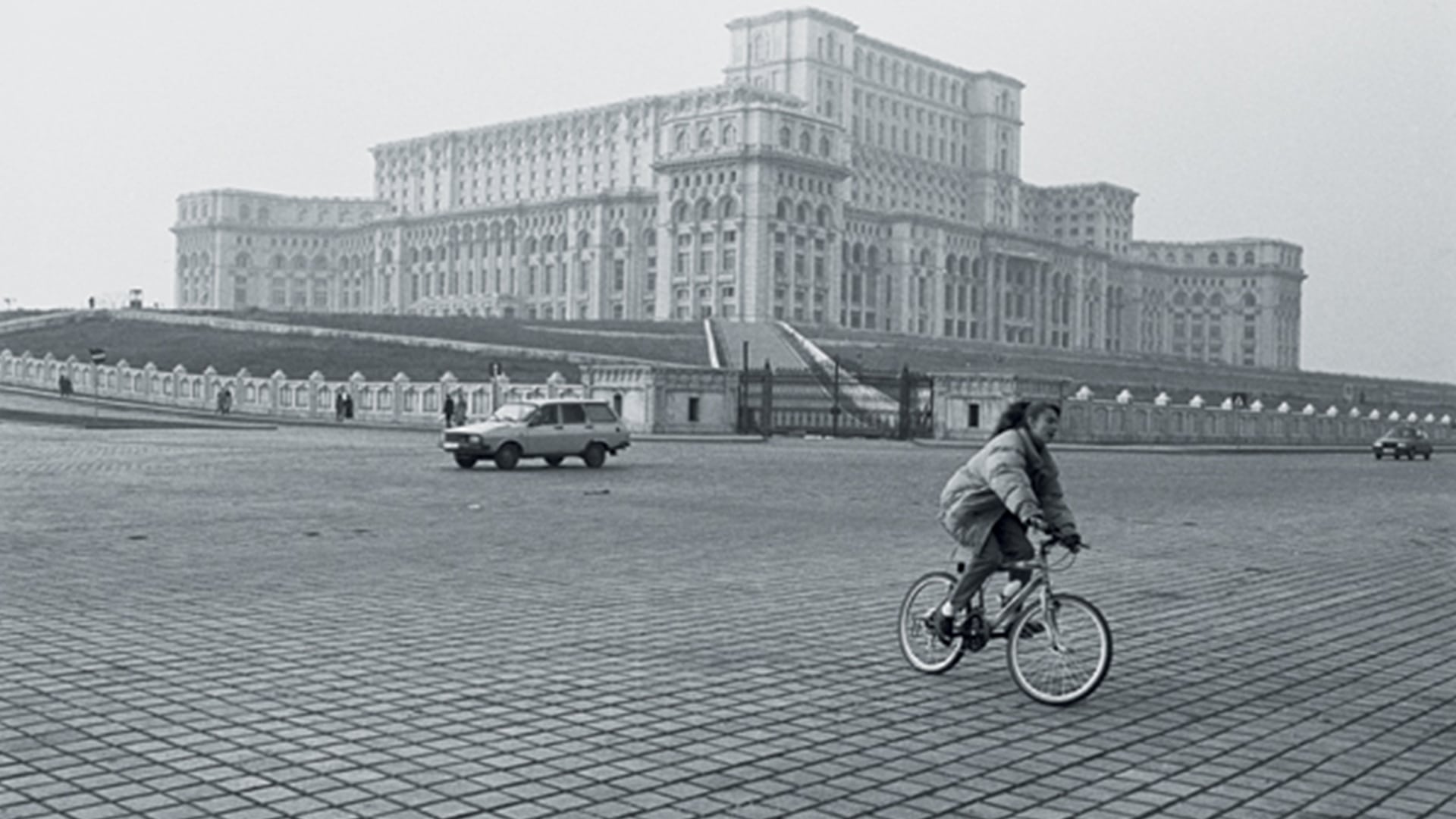
Bucharest’s Palace of the Parliament, formerly known as “The House of the People” (“casa poporului”), is one of Romania’s most iconic landmarks. The socialist-era building is the second-largest government building in the world and will likely be at the top of your to-do list if you’re planning a trip to Bucharest.
The Palace of the Parliament in Bucharest welcomes tourists all throughout the year, seven days-a-week. To visit, you’ll need to schedule your tour in advance, bring proper identification, and carry adequate cash to pay for your tour.
In this guide, I’ll walk you through planning your tour to this socialist relic and give you a glimpse of what you can expect from each tour package. I’ll also provide information that doesn’t appear on the building’s official tour site, like how to find the entrance (seriously, how did they leave this out).
Hours of Operation
Impressively, the Palace of the Parliament is open seven days-a-week year-round, though it is closed for government holidays. This site provides a list of government holidays in Romania.
It is important to note that the Palace of the Parliament is a functioning parliament building, so you cannot simply wander around on your own. As a tourist, you are only permitted in the building if you are taking part in an official, scheduled tour.
The building’s operational hours vary according to the time of year:
- March-October: Open daily from 9:00 am to 5:00 pm.
- November-February: Open daily from 10:00 am to 4:00 pm.
The last tour of the day begins thirty minutes before closing time, so keep this in mind when scheduling your visit.
Additionally, visitors are required to be at the information desk at least 15 minutes before their scheduled tour begins, otherwise the tour may be canceled without notice. Plan your trip so that you will have plenty of time to get to the building and find the information desk.
Tickets and Packages
Standard tour.
Adults: 40 lei ($10 USD)/person
Students: 20 lei ($5 USD)/person (19 – 26 years old, with a valid student ID)
Children: 10 lei ($2.50 USD)/person (7 – 18 years old)
Standard + Underground Tour (access 2 floors on stairs)
Adults: 45 lei ($11 USD)/person
Students: 23 lei ($6 USD)/person (19 – 26 years old, with a valid student ID)
Children: 15 lei ($4 USD)/person (7 – 18 years old)
Panoramic Tour – Terrace (lift access)
Maximum 6 people/group
Admission price: 600 lei ($150 USD)/tour
Scheduling your Visit
One cannot visit the world’s largest monument to Socialism without encountering some form of post-socialist bureaucracy.
Anyone who has visited Rome, where the Colosseum or Vatican can be visited on a whim, will be surprised by the amount of fussing it takes just to visit a landmark in this part of the world.
Before you can tour the Palace of the Parliament, you must schedule your tour, by phone, with a live operator, at least 24 hours beforehand. For most of you, this means you will have to make an international call in order to schedule your visit.
If your telephone provider does not allow international calls to Europe or if they charge an arm and a leg, then I recommend using Skype to place the call. I’ve used Skype many times in the past to make calls to landlines and cellphone numbers in Europe without any hassle. Simply create a Skype account, add $10 of credit, and place your call. It couldn’t be simpler, really.
You must schedule your tour by dialing either of these lines during operational hours:
- + 40 733 558 102
Luckily, the tour staff speaks English so you should be able to communicate easily when you call in. The scheduler should let you know if they have availability on the date you are requesting and what type of tours are being offered that day.
Finding the Entrance
Finding the entrance to the Palace of the Parliament can be quite daunting. The grounds are completely walled off except for a few designated places. Complicating matters further, the grounds are bordered by busy boulevards with few crosswalks.
The entrance you must use to arrive at the information desk is located on the north side of the palace, across from Izvor Park (Parcul Izvor). If you are traveling via metro, you’ll want to exit at Izvor station, located in Izvor park. From the station, you’ll have to walk through the park and toward the Palace.
Using the designated crosswalk, traverse Izvor Boulevard and enter the palace grounds where the car approach and security booth are located. Walk up the long sidewalk toward the building’s facade and enter through the doors at the center of the building.
Once inside, you will have to undergo a brief bag check and metal detector screening. Be careful not to bring anything sketchy (knives, lighters, fireworks, etc.). You will also be asked to present a recognized form of identification.
You must bring your valid passport in order to enter the Palace of the Parliament and participate in a tour.
Is It Worth It?
At a price point of just $10, it would be hard to argue against visiting the Palace of the Parliament.
The sheer scale of the Palace speaks to the grandiose vision of Romania’s brutal dictator, Nicolae Ceausescu, who demolished entire historic neighborhoods to make space for his grand tribute to socialism, the House of the People.
Walking through the building’s unused chambers and empty halls inspire visions of a different Romania, one far removed from the bustling shopping malls and commercial centers that now dot the cityscape. A visit to this monument allows for moments of reflection, fascination, and learning from the past.
Happy exploring.
Recent Posts
Bucharest vs Warsaw: Why Bucharest Wins
If you're traveling Central Europe as a tourist, digital nomad, or backpacker, then you've probably considered visiting Romania or Poland, if not both. In my opinion, Poland and Romania are...
Romanian: Official Language of Romania
What Language is Spoken in Romania? Romanian is the official language of Romania and it is spoken by the majority of the population. It is a Romance language that is closely related to Italian and...
- Art Galleries
- Memorial Houses
- Historical Buildings
- Hidden Gems
- Coffee & Shops
- Restaurants
- Night clubs
- About Bucharest
- Public Transport
The Palace of Parliament
"people's house".
One of the most interesting to visit tourist objectives in Bucharest is the Palace of Parliament . No matter how many other palaces have you visited in your lifetime, this grand edifice will impress you with its size and its architectural style. Did we say „architectural style”? In fact, most architects blame this palace for not having one but more architectural styles. Also called the People's House , during Ceausescu’s regime, this building is, in fact, a symbol of the old communist times, an extravagance if you want to put it that way. Thanks to its solid wood furniture, crystal chandeliers, impressive dimensions, huge marble columns and other carefully chosen interior design elements for each room, this palace is one of Bucharest's most visited tourist objectives.
Nowadays, the Palace of Parliament is the scene of interesting new media events, such as iMapp Bucharest .
The Beginnings
Shortly after the earthquake in 1977, the Romanian communist leader of the time, Nicolae Ceauşescu, initiated the plan to build a new political-administrative center in Bucharest, in the area of the Uranus hill, the higher part of the Dâmboviţa hill, area which was confirmed by specialists as being safe for the construction of monumental buildings. This plan started as a consequence of the urbanization campaign and it was influenced by the friendship with the North Korean leader at that time, Kim Ir Sen.
Starting in 1980, 5% of the Bucharest area was demolished. An area almost equivalent to the total surface of Venice. This was the end of Uranus neighborhood, the end of those small streets paved with cubic stone, with old and quaint Romanian houses with bohemian glamour, many of which brought to light by architects from that time. 20 churches were destroyed, 8 were moved, 10,000 homes were demolished, and over 57,000 families were evicted. Brâncovenesc Hospital which was the first forensic medicine institute in the world was demolished, also.
But this was only the beginning: People's House, the current Palace of Parliament, took almost 10 years of hard work that brought together over 100,000 workers, more than 20,000 persons working 24 hours three shifts per day. Between 1984 and 1990, 12,000 soldiers took part in the construction works, as well.
The building was erected with construction materials produced in Romania, amongst which: 1,000,000 cubic meters of marble, 550,000 tons of cement, 700,000 tons of steel, 2,000,000 tons of sand, 1,000 tons of basalt, 900,000 cubic meters of rich wood, 3,500 tons of crystal, 200,000 cubic meters of glass, 2,800 chandeliers, 220,000 sqm carpets, 3,500 sqm leather.
Interesting is the fact that, for the construction of the Palace of Parliament, all the foam models were made on a scale of 1/1000 presenting the entire Bucharest city, including the streets, plazas, buildings, houses and monuments, also with certain details. Some parts of the building, like stairs, for example, were made on a scale of 1/1! The Ceaușescu couple could not understand the architectural plans and this was the handiest plan for architects to show their plans. The couple was walking over the models on a rolling bridge, giving instructions. Every 7 days, the plans changed according to the new instructions given by the ruling couple.
In 1989, when the Revolution started, only 60% of the building was finalized. At that moment, giving the resentfulness of the population against the symbols of the past era, the demolition of the building was taking into account. Yet, following the economic considerations, it was decided to complete the construction as it was cheaper than demolishing it. Thus, between the years 1992 and 1996, the construction started again.
Now, when you are looking at this massive construction, you can see:
- the largest administrative building (for civil use), as confirmed by the Guinness World Records Book
- the 3rd place worldwide by its volume
- the heaviest and the most expensive building in the world
Sounds great, right?
So, let's have a look inside...
Inside the Building
We recommend you to quickly make a reservation for a tour. Worth a visit because what you will see here you will not see anywhere in the world!
Palace of Parliament Map Plan
Before presenting you a short description of each area that you are going to visit, let's show you the plan of the building. You will find this symbol inlaid in marble on the floor almost everywhere. Most people think it's just an intricate paint on the floor, but now you know it's not only that!
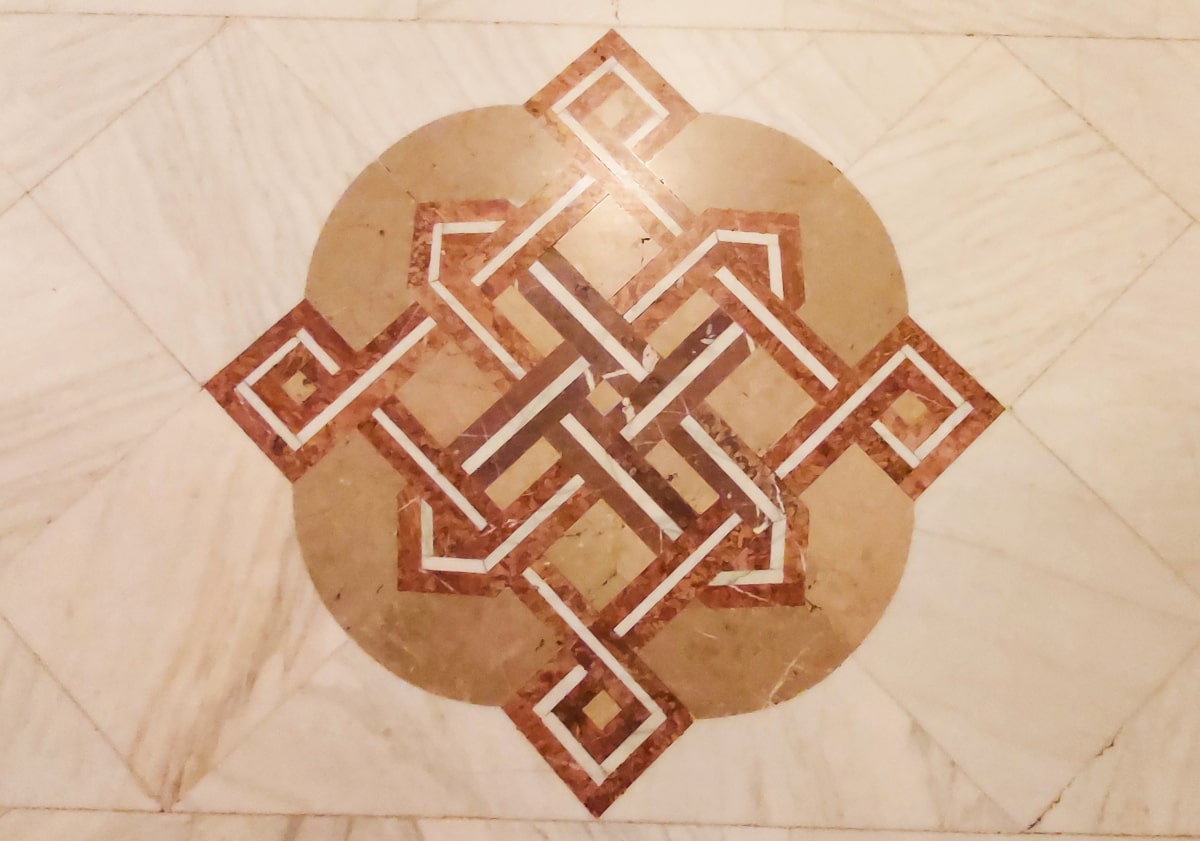
Palace of Parliament Official Entrance
With approximately 1000 rooms of which 440 are offices, more than 30 ballrooms, 4 restaurants, 3 libraries, 2 underground parking lots, 1 big concert room, 1 unfinished pool, and thousands of square meters in which no one knows what is happening, the Palace of Parliament offers you contradictory feelings every time you step on its doorstep.
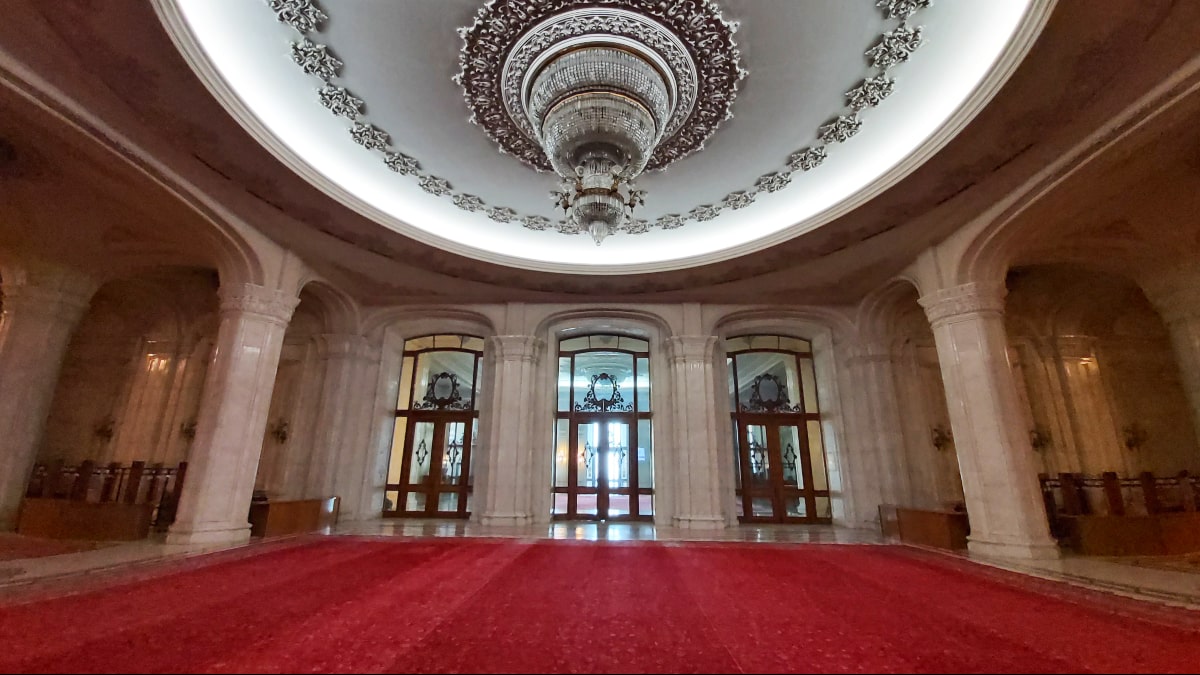
This is the official entrance. Often used as an official entrance when fairs, exhibitions or other events take place here, the entrance fascinates with the red carpet, the huge chandelier, and, especially, with the stairs you will see: one on the left and one on the right. Built-in a mirror, the two stairs were created especially so that the Ceaușescu couple could use them when they were to receive their guests. One would descend on one side, the other on the other, and meet in the middle. The steps are 13 cm high, less than the usual dimensions and this was also done on purpose. Thus, you could descend naturally, without looking at your feet and without taking bigger steps to climb them. Remember what we have told you about foam models of stairs that were made on a scale of 1/1? These are the stairs we are talking about! In front of each staircase, there is a window covered with curtains. These curtains hold the record for the tallest curtains in the world in an administrative building. Their weight exceeds 250 kg each!
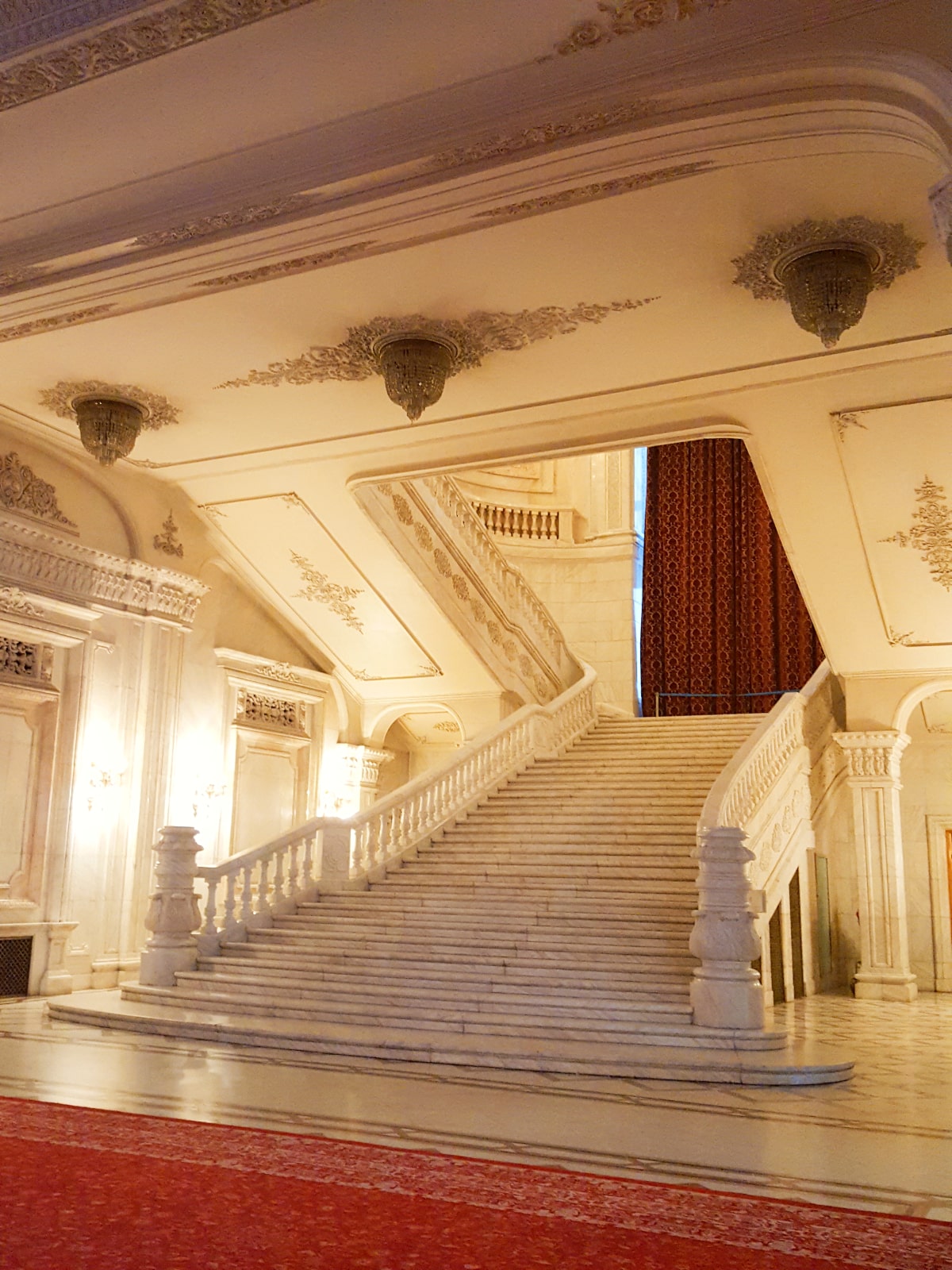
Nicolae Titulescu Hall
This Hall is currently used by the President of the Chamber of Deputies and President of the Senate during the official meetings. The French style was chosen to decorate this room. The color used for this camera was not randomly chosen. Pink is a neutral color and is not used by any political party. So, apart from the fact that it inspires calm, no one can accuse anyone of being subtly influenced in decision-making.
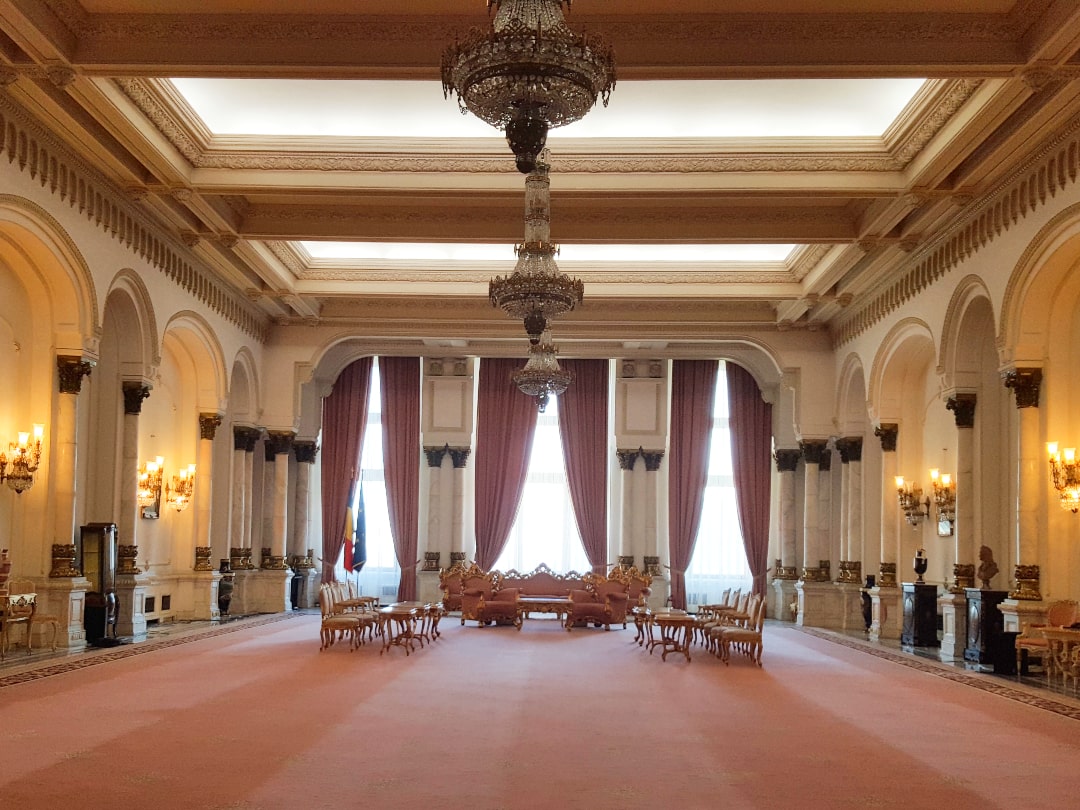
Human Rights Hall
This hall is one of the most impressive that you are going to see. It was projected in order to hold the meetings of the Executive Political Committee of the Communist Party. You will see here a huge round table, 60 identical chairs for the Executive Political Committee members (the armchair for Nicolae Ceaușescu was never finished), and the second-largest chandelier in the Palace of Parliament.
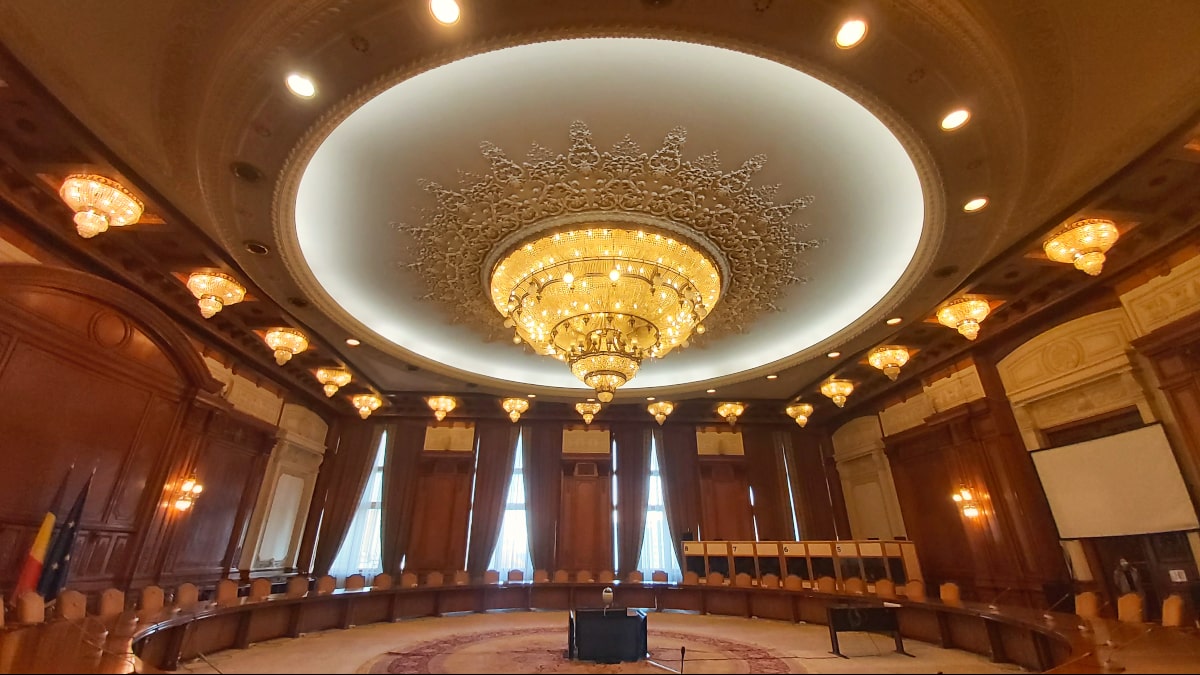
Take Ionescu Hall
This Hall does not have natural light, but the 12 chandeliers and the over 20 sconces manage to illuminate the room, highlighting the beauty of the columns that support it. Pay attention to the ornaments on the ceiling. They are covered with gold leaf. You will notice that the acoustics in this room are special and even the whispers are echoed. In this room, Ceausescu was to be received on the occasion of various events. At his entrance, everyone had to applaud enthusiastically. The echo would have made the applause louder, the effect becoming one with great impact.
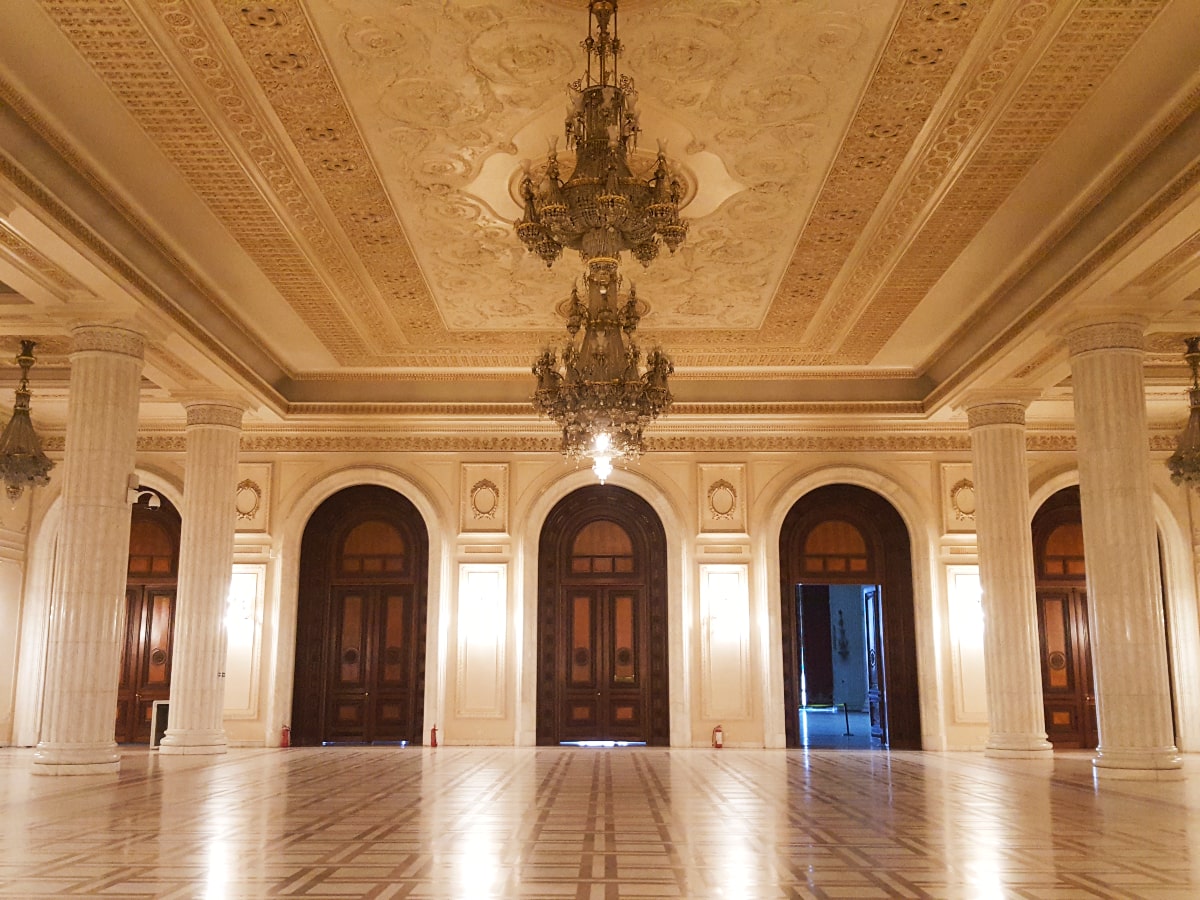
This is the largest hall in the building. It has 2200 sqm. The carpet you will see in this room (most of the time it is rolled because it is a room where many events take place) has 1100 sqm and weighs 3 tons. It was woven directly inside the room, being too big to be transported. On two of the walls of the room, on the left and your right, you will see the place where the portrait of Nicolae Ceaușescu should have been on one side and a huge mirror in which it should be reflected on the other side.
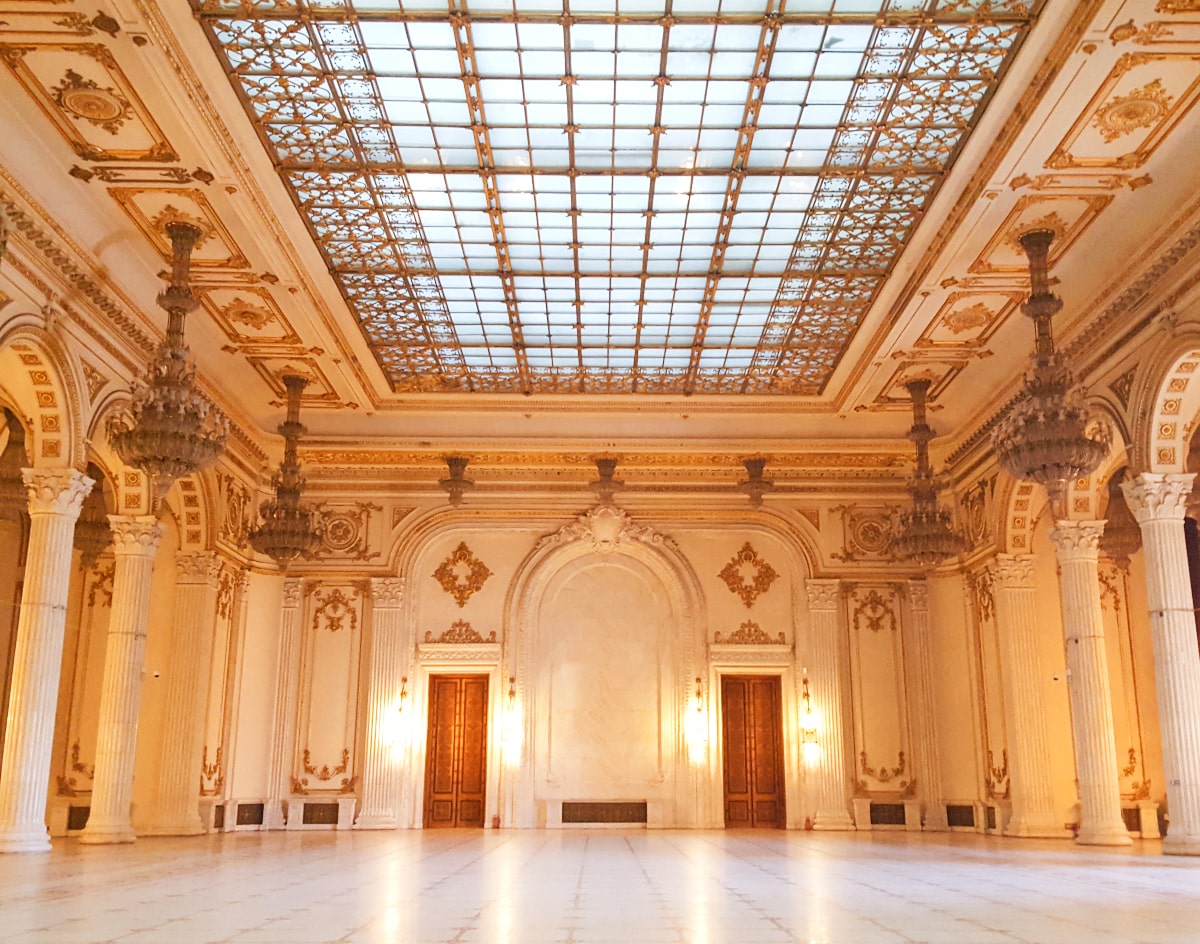
Alexandru Ioan Cuza Hall
At the end of your visit, you will see the Alexandru Ioan Cuza Hall. This hall is impressive due to its' highs (it is the highest in the Palace of Parliament), but also due to its balcony. From here you can see Unirii Boulevard. The only person who addressed the crowd speaking from this balcony was Michael Jackson in 1992. He addressed to his fans "Hello, Budapest!" instead of "Hello, Bucharest!", but he wasn't the first or the last personality to confuse the two capitals.
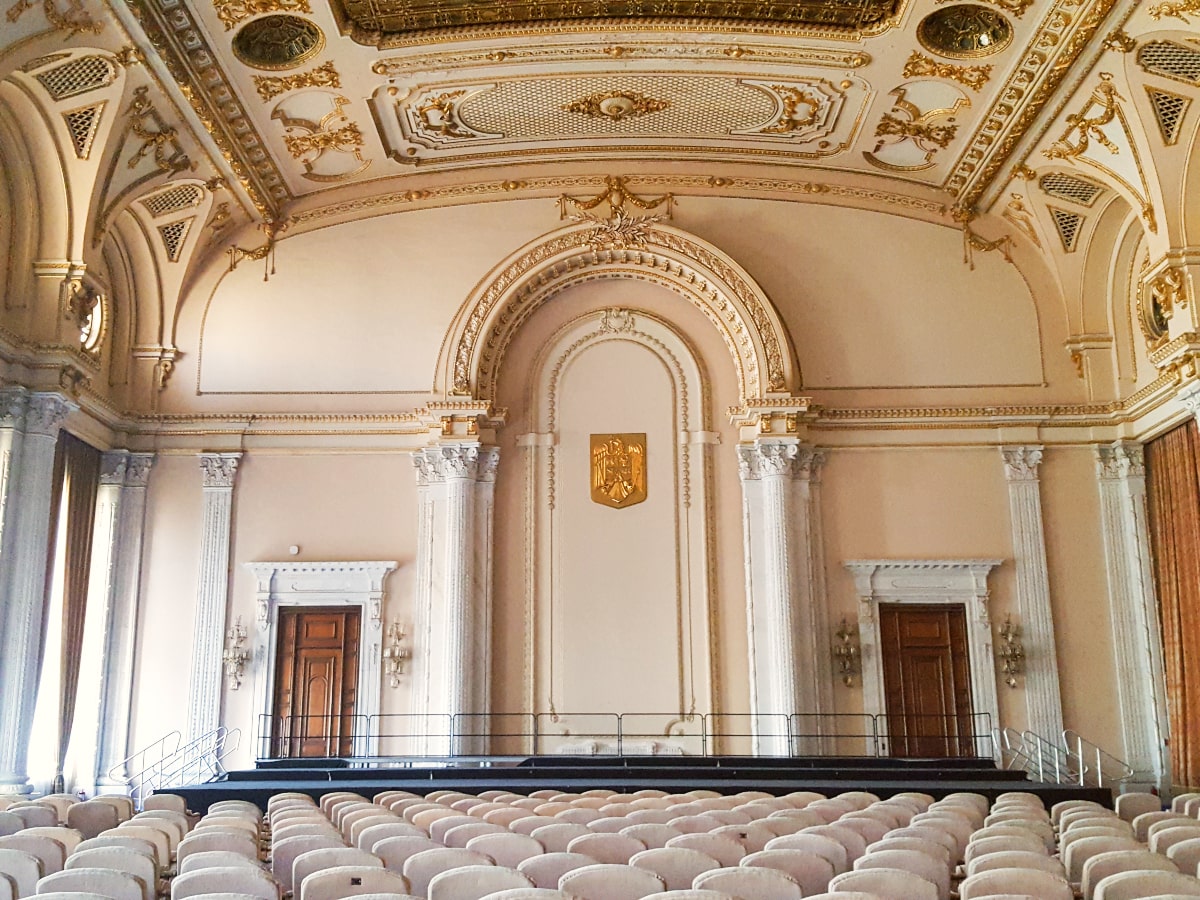
Would you like to learn more about the curiosities that make the Palace of Parliament one of the most impressive buildings in the world?
Opening hours & ticket price
- March - October, daily 09:00 am - 5:00 pm (last round at 4:30 pm )
- November - February , daily 10:00 am - 4:00 pm (last round at 3:30 pm )
Ticket prices:
Standard tour.
- Adults: 40 lei / person ~ 8 euro
- Students: 20 lei/person (19 - 26 years old, with student card approved) ~ 4 euro
- Children: 10 lei / person (7-18 years) ~ 2 euro
Standard tour + basement (2 stairs descent)
- Adults: 45 lei / person ~ 10 euro
- Students: 23 lei/person (19 - 26 years old, with student card) ~ 5 euro
- Children: 15 lei / person (7-18 years) ~ 3 euro
Tour Panorama of the city - Terrace (elevator access)
Maximum 6 people / group
- Single rate: 600 lei / tour ~ 125 euro
Standard Tour Package 35
- Single rate: 1400 lei / tour ~ 290 euro
Standard tour package + Basement 35
Single rate: 1575 lei / tour ~ 330 euro
Free admission for:
- children aged 0-6 years , accompanied; persons with disabilities (with evidence) and their companion; accompanying guide (for organized groups, minimum 10 adults).
- Professional photo shooting: 300 EURO/hour
- Professional film shooting: 5000 EURO/hour
- For professional photography and shooting, please send your request to [email protected] or to the fax number: + 40 21 312 09 02.
The tickets for the visit of the Parliament Palace are purchased on the day of the visit, only from the ticket office inside the Exhibition Hall "Constantin Brâncuși", Izvor Street, no. 2-4 . Payment can be made in cash or by bank card.
For reservation:
- Bookings for 1 to 9 people can be made only by phone, 24 hours prior to the visit, between 09:00 – 16:00, at the following telephone numbers: + 40 733 558 102 or +40 733 558 103
- Bookings for groups of 10 people + can be made at the following email address: [email protected]
- Requests for bookings made via email for 1 to 9 people will not be taken into consideration
View this post on Instagram A post shared by Visit Bucharest (@visitbucharest_today)

Get directions

- Attractions
- Bucharest Tours & Trips
[email protected]
© 202 4 All rights reserved.
Webdesigned and promoted by TUYA Digital
Privacy Policy Customer Protection
Bucharest: Palace of Parliament Guided Tour
- 7.80 / 10 19 reviews | 292 travellers Excellent organisation and information. Guide was fantastic. Highly recommended. 10 Beverly
- Free cancellation up to 48 hours before the service starts
- X (Twitter)
Did you know that the Palace of Parliament in Bucharest is the largest administrative building in the world ? On this guided tour, we'll visit the most iconic and important parts of this architectural landmark – a real privilege!

Palace of Parliament Guided Tour
At the indicated time, we'll meet at Bulevardul Natiunile Unite 4 . From there, we'll walk towards the Palace of Parliament , an a rchitectural gem of Bucharest .
From the entrance to the foyer, we'll start the visit by walking through the Hall of Honour , decorated with several busts of Romanian kings . This image will give us an introduction to start immersing ourselves in the historical importance of the building.
We'll continue the tour in one of the most prominent halls of the Parliament, the Balcescu Room , which is currently used for international conferences . Then, we'll reach the Kogalniceanu Room and the Music Hall , where renowned musicians from all over the world have performed.
Afterwards, we'll see the famous Pink Room , also called the Nicolae Titulescu Hall , used for meetings between public officials. You'll see that it actually is all pink, it's like a fairytale palace !
Our penultimate stop will be at the Ballroom of the Palace of Parliament in Bucharest , the largest in Europe. Did you know that it's the size of 4 football fields?
We'll finish the guided tour on the balcony , with magnificent panoramic views of Piața Constituției . Finally, on the way to the exit we'll walk through corridors housing paintings by Romanian artists .
After an hour-long tour inside the building, we'll say our goodbyes and put an end to the tour. See you next time!
More Information
The activity takes place with a guide that speaks in English.
English–speaking guide
Admission to the Palace of Parliament
Not included
Food and drinks
When to book?
You can book up until 4 hours before the activity as long as there are still places. Book now to guarantee your spot.
Type of voucher
Electronic. Show the voucher on your phone.
Accessibility
Not wheelchair accessible.
Sustainability
All services published on Civitatis are carried out in accordance with our Sustainability Code .
Our providers commit to:
- Provide a safe and satisfying experience.
- Reduce, reuse, recycle.
- Incorporate eco-conscious technologies.
- Uphold fair employment standards.
- Foster the growth of local communities.
- Preserve the integrity of local culture.
- Safeguard both cultural and environmental heritage.
- Ensure ethical treatment of animals.
- Operate with honesty and transparency.
- Encourage sustainable behaviors among customers and staff.
This particular activity contributes as follows:
- No printing of documentation required.
- Promotes local employment.
- Has a gender equality policy.
- Has a carbon footprint offset policy.
Transylvanian Wonders Show more
Corporate name: SC Transylvanian Wonders SRL
Not permitted.
Frequently asked questions
Q - Why do this activity with Civitatis?
A - At Civitatis we guarantee the best quality and prices, click here if you want to know how we select our activities .
Q - How to book?
A - To reserve the activity, choose the date and complete the form on this page. You will receive your confirmation immediately.
If you have any other questions please contact us.
Free cancellation
Meeting point.
Bulevardul Natiunile Unite 4
You may also be interested in
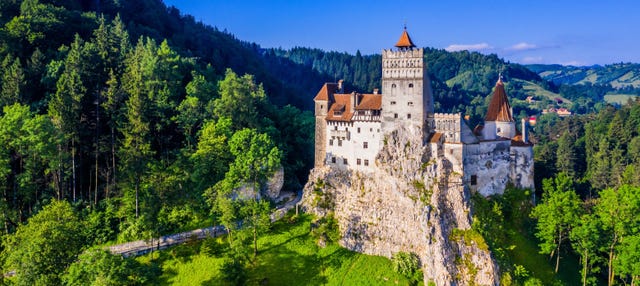
Bran and Peles Castle Day Trip
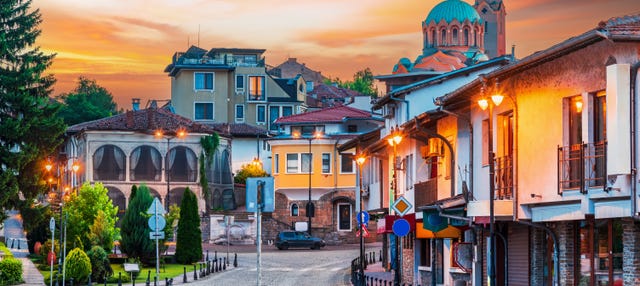
Day Trip to Bulgaria

Free Walking Tour of Bucharest
- Bucharest Attractions
- Palace of Parliament Bucharest
- National Museum of Contemporary Art
- Plan Your Visit
- Bran Castle Tickets
- Therme Bucuresti Tickets
- Peleș Castle Tickets
- Ceausescu Mansion Tickets
- Dimitrie Gusti National Village Museum
- Slanic Salt Mine Tickets
- Transfagarasan
Discovering the Majestic Palace of Parliament Bucharest: A Detailed Guide
Also Known As
People's Palace / House of the Republic
Nicolae Ceaușescu

Quick information
Strada Izvor 2-4, București, Romania
RECOMMENDED DURATION
VISITORS PER YEAR
NUMBER OF ENTRANCES
EXPECTED WAIT TIME - STANDARD
30-60 mins (Peak), 0-30 mins (Off Peak)
EXPECTED WAIT TIME - SKIP THE LINE
0-30 mins (Peak), 0-30 mins (Off Peak)
Did you know?
The Palace of Parliament Bucharest has several names that mirror its rich history and political importance. Locals often refer to it as the "People's House Bucharest" or "People's Palace Bucharest," while other titles like the "Palace of the People," "House of the Republic," "Romanian Parliament," and "The Ceausescu Palace" are also used.
The Palace of Parliament serves a variety of purposes, housing not only the Romanian Parliament but also museums and conference centers. It's home to the Chamber of Deputies and the Senate and even offers exhibition spaces. Beneath its many floors, you'll find nuclear bunkers and hidden tunnels, adding to its intrigue.
The Palace's construction stirred a lot of controversy, displacing thousands of residents and sparking widespread dissatisfaction. Entire neighborhoods were razed overnight, forcing over 40,000 people out of their homes and demolishing 9,000 houses, as well as historic landmarks and churches.
Highlights of the Palace of Parliament in Bucharest

Main entrance

A glimpse inside the Palace of Parliament Bucharest: what to see and do?

The main entrance, or the official entrance of Bucharest's Palace of Parliament, is a spectacle on its own, with two giant staircases on either side of the room built specifically for the King and his wife’s grand entry during events. You are greeted by a beautiful red carpet and an unmissable chandelier as soon as you enter the Romanian Parliament building, setting the tone for what to expect in terms of grandeur and architecture.

Magnificent decorations
The Palace of Parliament in Romania is a treasure trove of lavish interiors adorned with gold leaf and crystal chandeliers and grand furnishings. Inside, you can see the exquisite craftsmanship displayed in the ornate ceilings, detailed statues, intricate woodwork, and luxurious furnishings throughout the palace. Don't miss the stunning crystal chandelier in the Union Hall, a masterpiece weighing over 3 tons and composed of thousands of crystals.

Human Rights Hall
The Human Rights Hall is arguably one of the most aesthetic areas of the Bucharest parliament building. It was built to conduct meetings of the executive political committee of the Communist Party during Nicolae Ceaușescu’s reign. The 60-seater round table, long pastel-colored curtains, stylish interiors, and the second-largest chandelier in the parliament palace come together to create one of the grandest and most impressive rooms you will ever see.

Take Ionescu Hall
The Take Ionescu Hall, just like all the other areas in the Palace of the Parliament, is nothing short of impressive. Characterized by long supporting pillars, magnificent arches, and ornate interiors, this hall is one of the most fascinating rooms in the Palace of the Parliament because of its acoustics. The acoustics elements were designed to create a grand euphoric effect when people applauded Ceaușescu while welcoming him during special events.

Nicolae Titulescu Hall
The Nicolae Titulescu Hall inside the Palace of the Parliament in Bucharest, Romania, is currently used to host and conduct official meetings by the President of the Senate and the President of the Chamber of Deputies. The interiors and architecture of this magnificent hall have a French influence, with beautiful arches on either side of the room, tall curtains, a soothing pink carpet, and a stunning chandelier.

With more than 2200 square meters in area, the Union Hall is the largest hall within the Romanian Parliament building in Bucharest. You will notice 10-meter-long empty arched spaces on either side of the room for Ceaușescu and his wife's portrait. However, their portraits never made it there. Although the story isn't verified, legend has it that Ceaușescu wanted a retractable roof so that his helicopter could land or take off from the hall.

Alexandru Ioan Cuza Hall
Considered to have the highest ceiling in the Parliament House of Bucharest, the Alexandru Ioan Cuza Hall offers views of Unirii Boulevard thanks to its balcony. Interestingly, Ceaușescu wasn't the first to address the crowd from here, but global icon Michael Jackson. Jackson, to date, remains the only person to address a crowd from the balcony.

The National Museum of Contemporary Art
Immerse yourself in the vibrant contemporary art at the National Museum, one of Romania's most important art museums. It is located in the glass wing of the palace, showcasing thought-provoking exhibits by Romanian artists that highlight Romania's cultural evolution. Also, don't miss the museum's rooftop terrace, offering panoramic views of Bucharest's skyline.
You can also stroll through the Bucharest Parliament Square, the vast plaza in front of the palace building, and admire its impressive architecture. Capture memorable photos with the grand palace as a backdrop while enjoying the lively atmosphere of this central gathering place.
Palace of Parliament Bucharest stats – the grandeur explained in numbers
- Surface area: 365,000 sqm
- Guinness World Records: Largest administrative building (for civil use), Third-largest in the world by volume
- Dimensions: Length - 270 m, Width - 245 m, Height - 84 m (over 0 level), Depth - 16 m (underground level)
- Building footprint area: 73,615 sqm
- Construction materials: - 550,000 tons of cement - 1,000,000 cubic meters of marble - 700,000 tons of steel - 2,000,000 tons of sand - 3,500 tons of crystal - 1,000 tons of basalt - 900,000 cubic meters of rich wood - 200,000 cubic meters of glass
- Interior features: - 2,800 chandeliers - 220,000 sqm of carpets - 3,500 sqm of leather
- Workforce: Over 100,000 workers, with more than 20,000 persons working 24 hours across three shifts per day.
History of Palace of Parliament Bucharest

- The Palace of Parliament was built because Romania’s controversial communist leader, Nicolae Ceaușescu, wanted to show off his power and also because he wanted a safe haven to live in that would hold up even a nuclear attack.
- Ceaușescu decided to build the Palace of Parliament at a time when Romania was crippled financially due to mismanagement of medicine, food, funds, etc, causing resentment among people.
- The construction of the palace came at a significant cost, both in terms of resources and human lives. It is estimated that tens of thousands of workers toiled on the project, often under harsh conditions. Additionally, entire neighborhoods were demolished to make way for the building, displacing thousands of residents and sparking controversy both at home and abroad.
- It took around 13 years to construct the Palace of Parliament from 1984 to 1997. The interesting part is that the Palace of Parliament building was not ready when Ceaușescu was executed during the Romanian Revolution of 1989.
- Since the fall of communism, the palace has transformed, now serving as the seat of the Romanian Parliament and hosting various cultural events and international conferences. What was once the symbol of socialism, totalitarianism, and communism has now become a symbol of democracy.

Architecture of the Palace of Parliament, Romania
- The Palace of Parliament was designed by architect Anca Petrescu and built by a team of over 20,000 workers using materials from all over Romania. Its construction was a monumental undertaking, with no expense spared to showcase the might and prestige of the Romanian state.
- With over 1,100 rooms spread across an area of 365,000 m2, the Palace of Parliament is the second-largest administrative building and the heaviest building in the world.
- The architectural style of the Palace of Parliament is a blend of neoclassical and socialist realism, characterized by large supporting columns, long doors, lavish staircases, elegant arches, and football-sized rooms.
- One of the most remarkable features of the Palace of Parliament is its underground network of tunnels, which were intended to serve as escape routes during an emergency. These tunnels extend for miles beneath the surface, connecting various government buildings and providing a glimpse into the secretive world of Cold War politics.
Frequently asked questions about Palace of Parliament Bucharest
The Palace of Parliament Bucharest, also known as the People's Palace, is famous for its sheer size, opulent design, and controversial history. Spanning over 365,000 sqm and boasting over 1,100 rooms, the Bucharest Parliament House is the heaviest building in the world and the most expensive and controversial construction project of the 20th century. It is also an architectural masterpiece crafted from Romanian materials, employing traditional motifs alongside neoclassical and modernist elements.
The history of the Palace of Parliament Bucharest is steeped in controversy due to its association with Romania's communist regime under Nicolae Ceaușescu. Construction of the palace began in 1984, at a time when Romania was facing economic hardships and political oppression. The project resulted in the forced eviction of thousands of residents from the area, as well as the demolition of historic neighborhoods, including churches, synagogues, and homes, leading to widespread public outcry. Additionally, the lavishness of the palace, contrasted with the poverty experienced by many Romanians during that period, fueled further resentment and criticism.
The main entrance, Union Hall, Take Ionescu Hall, Alexandru Ioan Cuza Hall, Human Rights Hall, and Nicolae Titulescu Hall are some of the must-see areas at the House of Parliament Bucharest.
Allocate an hour to visit and explore the Palace of Parliament in Bucharest. Allocating an hour gives you ample time to see the different rooms, admire the intricate interiors, and learn about the rich and controversial history of the People's Palace Bucharest.
Yes, the Palace of Parliament Bucharest guided tours are available. These comprehensive tours offer in-depth insights into the palace’s history, architecture, and Ceaușescu’s life.
Yes, the Palace of Parliament Bucharest is wheelchair accessible. The curb-free entrances, accessible parking lots, elevators, and washrooms ensure disabled visitors can enjoy the entire experience without any hassle.
The best time of the day to visit the Palace of Parliament in Bucharest, Romania, is early in the morning to avoid large crowds. Additionally, visit the palace on a weekday to stay clear from the weekend rush.
Some of the other attractions near the Palace of Parliament Bucharest include the Revolution Square, Constitution Square, National Museum of Natural History, and Ceausescu Mansion .
Yes, skip-the-line tickets are available for visitors who wish to explore the Palace of Parliament Bucharest without the hassle of waiting in long queues. These tickets typically include priority access to the Palace of Parliament, Romania, a guided tour in English or Spanish, and the booking fee, ensuring a seamless and enjoyable experience for the visitors.
Yes, photography is allowed at the Palace of Parliament Bucharest; but, there are some restrictions to be aware of. Visitors are permitted to take photos using their mobile cameras free of charge. However, a small fee may apply if you wish to use a professional camera or equipment.
The Palace of the Parliament in Bucharest: History, facts and tours
I will never forget the odor when I entered the Palace of the Parliament in Bucharest . To this day, I can’t decide if it was just bad air or if somebody failed to boil cabbage properly. Somehow, this smell inside the Palace of the Parliament can still trigger a set of impressions from my visit. It was actually this building that made me want to visit Bucharest. Therefore, taking a tour through the Palace was a high priority when I visited Romania’s capital.
The so-called Casa Poporului , or The People’s House, is an impressive building lots of records are associated with it. In this article, I’m going to present to you my impressions of the tour, lots of facts, photos, plus a video. If you’d like to book a tour, make sure to check the section at the bottom of this post, where I link to the best tours to the Palace of the Parliament.
So, let’s start.
Table of Contents
*Some of the links are affiliate links. It means that if you buy something, I might earn a small commission at no additional cost to you.
An introduction to the Palace of the Parliament in Bucharest
The Palace of the Parliament is the heaviest building in the world . It actually weighs 4,098,500,000 kilos, and it is supposedly sinking a few millimeters per year. It is located in Bucharest, Romania’s capital, and its construction lasted 13 years: it started in 1984 and finished in 1997. The idea of constructing such a massive building belonged to Nicolae Ceausescu, the Romanian Communist Party’s general secretary. Ceausescu was executed in December 1989 during the Romanian Revolution, which was an era of political turmoil for the country. That said, Ceausescu never saw the building he envisioned.
The architect that supervised the construction of the Parliamentary Palace was Anca Petrescu. She wasn’t, of course, alone in this task. She actually had 700 architects with her. The number of workers is equally impressive: more than 21,000 people worked on the project. Nicolae Ceausescu wanted to prove that he could build it using Romanian materials and local workers exclusively. It was a house for the people, after all. Those 21,000 workers worked in three shifts, 24 hours per day. That said, for these 13 years, people were working on the project non-stop.
Today, the building houses the Senate and the Chamber of Deputies, the two sections of the Parliament of Romania. In addition, several museums are hosted in the building, among them the Museum for Contemporary Art of Romania . But of course, these things occupy just a tiny percentage of its use. The Palace of the Parliament has more than 1,000 rooms . There are also offices operating in the building, and its number is calculated to be 440. The Palace itself occupies an area of 365,000 square meters.
Known also as the House of the Republic, Ceaușescu’s dream building is also the world’s largest civilian building with an administrative function. It’s also the second biggest administrative building in the world after the Pentagon. In the early ’90s, Rupert Merdoch tried to buy it for 3 billion dollars. However, the Romanian State didn’t accept his offer. To this day, the Palace of the Parliament is also the most expensive administrative building in the world.
Taking a tour of the Palace of the Parliament
Everyone can visit the Palace of the Parliament in Bucharest. However, walking through its interior is only possible with a guide. You can either sign up for a tour in the Palace directly from the website of the Parliamentary Palace or find a tour online. The day I visited the Palace, I was lucky enough to arrive on time for an English guided tour. However, as I figured out, not every tour is in English. Therefore, cross-check if the tour you’re about to take is in English.
As an alternative, you can pre-book an English-speaking tour online. There are actually a few certified guides offering them. You can book a tour here and also here . Make sure to arrive fifteen minutes in advance : it’s obligatory to go through a security check. Bring also your passport with you; otherwise, you won’t be allowed to enter.
It honestly feels like being in an airport. And the truth is that maybe you are: you’re about to land in a different era.
What you’ll see in the Parliamentary Palace tour
As I wrote earlier, this is the biggest administrative building in the world. You will probably need days to tour all around it. Even the people working there haven’t seen the whole building. The visitors taking the Parliamentary Palace tour will only have access to 5% of the building. You will walk approximately 1,5 kilometers , and you will visit a couple of rooms. If you add the so-called Underground option to your tour, you’ll also see some rooms in the basement. For the latter addition, make sure you are fit enough to take the stairs. You should calculate approximately 300 stairs in total -but not in one strike, of course.
According to online information, the tour lasts about two hours. This is probably an exaggeration, though: the tour I took lasted one hour and fifteen minutes. I think that the two-hour timeframe considers things like unforeseen delays or a group that might ask lots of questions.
How much does the tour of the Palace of the Parliament cost?
As of 2021, the tour costs 45 lei. That’s approximately 9-10 euros/dollars . If you book one of the various tours that you can find online, expect a few extra euros since you’re also paying for the guide. By booking online, though, you reserve a place, so you’re sure that you won’t miss it. I’ll add the two best tours at the bottom of this post.
There is no extra charge for shooting photos. I double-checked that because I wanted to shoot both photos and videos. I had my Ricoh with me as well as the DJI Osmo Pocket . During the tour, I also saw people carrying large DSLRs. That said, you don’t have to worry about your bulky DSLR. Have it with you because the Palace of the Parliament in Bucharest is a great attraction and you want to remember everything about it.
What to expect from the tour to Parliamentary Palace
The guides are very knowledgeable and friendly. They will always ask you if you have any questions, and they are happy to answer them. They will also provide lots of information, but it’ll be hard to remember every detail unless you write everything down or record it. The only downside of the tour for me was that it felt pretty short. In one hour and fifteen minutes, it’s hard to digest what you see. Plus, if you (like me) would like to shoot photos and videos, you’ll have to sacrifice some of the info for finding and composing your images.
The day I took the tour, I counted approximately 35 people in the group. In some of the rooms, you won’t walk inside; therefore, everybody will stand in front of the door. That said, if you’d like to take some decent photos, you’ll have to wait until the group moves on to the next room. Of course, you’ll then lose some info.
Overall, I’m happy that I had the Parliamentary Palace tour . It offers a memorable experience because, in this building, modern history was written. Apart from that, the scale of the building itself is breathtaking. If you are into history or simply interested in such things, this is one of the must things to do in Bucharest.
20 quick facts about the Palace of the Parliament in Bucharest
Before presenting even more photos (and a video) from the tour, I’d like to add some quick facts about the building. Plus, I got some info from our tour guide that might not be available anywhere else online.
- You can access the Palace of the Parliament only from the side of Izvor Park. Since the building is enormous, don’t lose time searching for the entrance. Walk straight to Izvor Park and cross the street.
- The English-speaking tours usually start early in the afternoon. Mine began at 14:00, some of the online ones start at 15:00.
- The tour will last approximately one hour and fifteen minutes . I think that the two hours that you’ll see online is probably an exaggeration.
- You can take photos everywhere in the interior but not at the security check . So keep your cameras and smartphones down.
- Before starting the tour, you will be given a badge. You’ll have to return it when exiting, so if you are into such memorabilia, make sure to take a photo.
- Don’t forget your passport ! Without it, you can’t enter the Palace of the Parliament. Remember that this is an administrative building and people want to know who’s attending.
- One of the paintings that you will see presents the back of a woman. This is supposedly Ceausescu’s wife, Elena. Her back is naked, and rumor says the painter didn’t want to use her as a model because he found her ugly. Some other stories say that Elena was, in fact, running the State, not Nicolae.
- When you are accessing the first floor, you will see huge curtains hanging in front of the windows. They are dark red in color, sixteen meters high, and they weigh 200 kilos each.
- Sabin Balasa was one of the most famous artists in Romania. One of his most known paintings is in the Palace of the Parliament. Its name is “ Apotheosis ,” and it’s from 1984.
- Along the long corridors of the Palace, you’ll also see traditional Romanian costumes . Some of them are more than 100 years old.
- The Palace of the Parliament is not far away from the city center. You can easily access it on foot .
- There are days that international conferences and other events take place in the Palace. However, even on the busiest days, only 65% of the building is in use .
- Nicolae Ceausescu dreamed of having a theater in the building. And indeed, there is one, but it was never used as such. The reason? Well, there was not enough reason for backstage. By the way, the chandelier in that room weighs 3,000 kilos.
- Since Romania has major earthquakes from time to time, there are visible damages on some walls.
- The Palace also has eight underground levels , and the very last one is a nuclear bunker. The walls are 1,5 meters thick, and radiation cannot penetrate them.
- According to the official website, in the standard tour, you’ll visit the following rooms: The Press Gallery, The Gallery of Honour, The “Nicolae Iorga” Hall, The “Nicolae Bălcescu” Hall, The “Nicolae Titulescu” Hall, The “Drepturilor Omului” Hall, The C4 Hall, The “I.I.C. Brătianu” Hall, The “Take Ionescu” Hall, The “Unirii” Hall, The “Al. I. Cuza” Hall, The Gallery of Honour, The Press Gallery, The “C. A. Rosetti” Hall. Taking the extended tour will grant you access to some underground areas as well.
- The tour is, unfortunately, not accessible to people with mobility disabilities.
- Most of the materials were produced in Romania . Among them: 1,000,000 cubic meters of marble and 550,000 tons of cement.
- The palace’s location was not an empty space before: 20 churches were destroyed, 8 were moved, and 10,000 homes had to be demolished. The State evicted more than 57,000 families.
- Before the Revolution of 1989, the Parliamentary Palace was a symbol of Socialism. After 1989 it became a symbol of Democracy because it hosts several public institutes.
A short video from the Palace of the Parliament in Bucharest
So, here you can see a 6-minute video from the Palace. I tried to include as much footage as possible. Moreover, I preferred not to add any music and let you hear what the tour guide had to say.
Opening times of the Palace of the Parliament
The Palace is open daily from 10:00 a.m. to 4:00 p.m .
More photos from the Palace of the Parliament in Bucharest
So, in this section, you can see some extra pictures from the tour.
Book your tour for the Palace of the Parliament
Here you can find four selected tours for the Parliamentary Palace . All of them will book tickets for you; therefore, you won’t have to queue. There’s, of course, a guide to help you navigate through the building, and they will provide lots of info. The tours are in English. You have the following options:
- Palace of the Parliament skip-the-line tour . This one is exactly what its name says: you’ll skip the line and take the tour without waiting in the queue. You can book this tour here .
- Parliamentary palace tour with Pickup . This option offers a plus: the tour guides will pick you up from your hotel in Bucharest. The Palace’s ticket is included in the price. Check this tour here .
- Private Bucharest full-day tour with entrance fees . That’s probably the most comprehensive Bucharest tour you’ll find online. The guides will pick you up from your accommodation, and you’ll have a full day tour in the city. A visit to the Parliamentary Palace is, of course, part of the price. Book the full-day tour here .
- Communist tour . As its name betrays, this is a tour dealing with the communist past of the city. It’s a private full-day tour around Bucharest, including, of course, the Palace of the Parliament. If you have a thing for modern history, then this one is for you. Book the Communist tour here .
So, that was it with my article about the Palace of the Parliament in Bucharest. Please let me know if you have already visited the Palace and your thoughts about it.
More about Bucharest : My travelogue from the capital of Romania & Bucharest travel guide
*Get my FREE Travel Writing Course*
Buy the camera I use
Pin it for later
Please share, tweet, and pin if you enjoyed reading about The Palace of the Parliament in Bucharest . Your support keeps this website running and all the info up-to-date. 🙂
Last Updated on November 23, 2021 by George Pavlopoulos
- More Options
- Share on LinkedIn
- Reddit this!
- Save in Pocket
- Save on Flipboard
- Share on Tumblr!
- Share via Telegram
- Share via WhatsApp
- Send via Viber
Related Posts
Street photography in bucharest, things to do in bucharest: a travel guide to romania’s capital, bucharest and the old town blues, leave a reply cancel reply.
Your email address will not be published. Required fields are marked *
- Skip to primary navigation
- Skip to main content
- Skip to primary sidebar
- Black Travel
- Destinations
- Travel Resources
Visit to the Palace of the Parliament in Bucharest
20/12/2021 by Roobens 1 Comment
Some links are affiliate links, which means if you make a purchase through these links, I earn a commission, at no extra cost to you.
The palace of the Parliament is a must see when you go to Bucharest . It’s the world’s second largest administrative building, after the Pentagon. It’s also the most expensive administrative building and the heaviest building in the world. And honestly, when you visit it, you understand why the palace of the parliament holds all this records! I was really looking forward to my visit to the palace of the parliament in Bucharest!
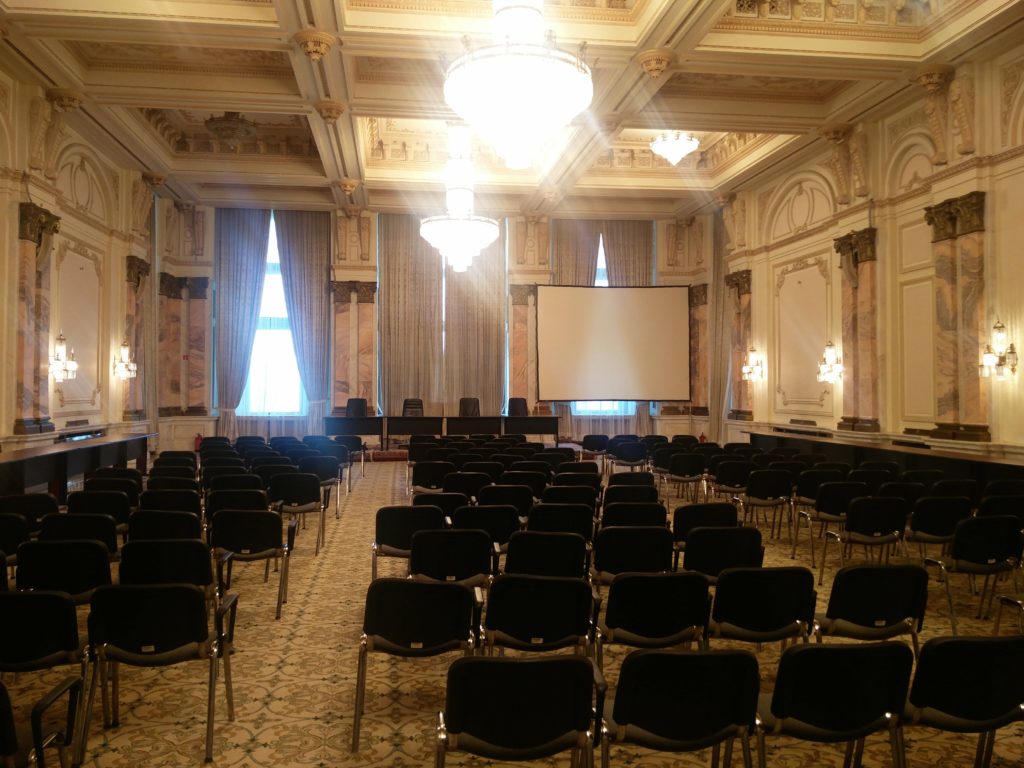
Table of Contents
History of the palace of the parliament
The palace of the Parliament was originally called People’s House. The construction of the Palace began in 1984, on the initiative of Nicolae Ceausescu, the Romanian dictator . His dream was to live in a tremendous palace (to show off), and to gather in this palace the presidency of the republic, the great national assembly, the council of ministers, and the supreme court. He didn’t have the opportunity to fulfill his dream, he was executed in 1989 not long before the end of the building.

But still, because of this palace, a lot of people worked really hard. About 600 architects and 20000 laborers worked on it, 40000 people were evicted and rehoused, whole villages were also working on the project… After Nicolae Ceausescu’s death, the governement decided to finish the palace, since it was already too advanced, a lot of resources had been used, and a lot of money had been spent.

Visiti to the People’s House
So it’s now possible to visit the palace of the parliament, and to see the opulence in which Ceausescu wanted to live. They propose visits in Romanian, English, French and Italian. I took the one in English, they propose them on a regular basis (at least one every hour), and I had to wait almost two hours for the one in French. Moreover I didn’t want to be the only person with the french guide… There are three types of tickets :
- The standard tour for 35 lei (7 euros)
- The standard tour + palace and terrace for 45 lei (9 euros)
- The full tour (standard + palace and terrace + underground) for 55 lei (11 euros)
FYI, it’s also possible to buy a skip-the-line ticket. Click here to buy it .

No pictures with your camera
Honestly, from what I could see, you get to see everything just with the standard tour ticket so it’s useless to take the full tour. Keep money in your pockets 🙂 Little detail I have to tell you, if you want to take pictures in the palace of the parliament with your camera, you have to pay an extra 30 lei (6 euros). But with your phone, it’s free. I saw people taking pictures with their cameras, although they didn’t pay to do it. Actually, they don’t really pay attention, but I suggest you not to do it, who knows…
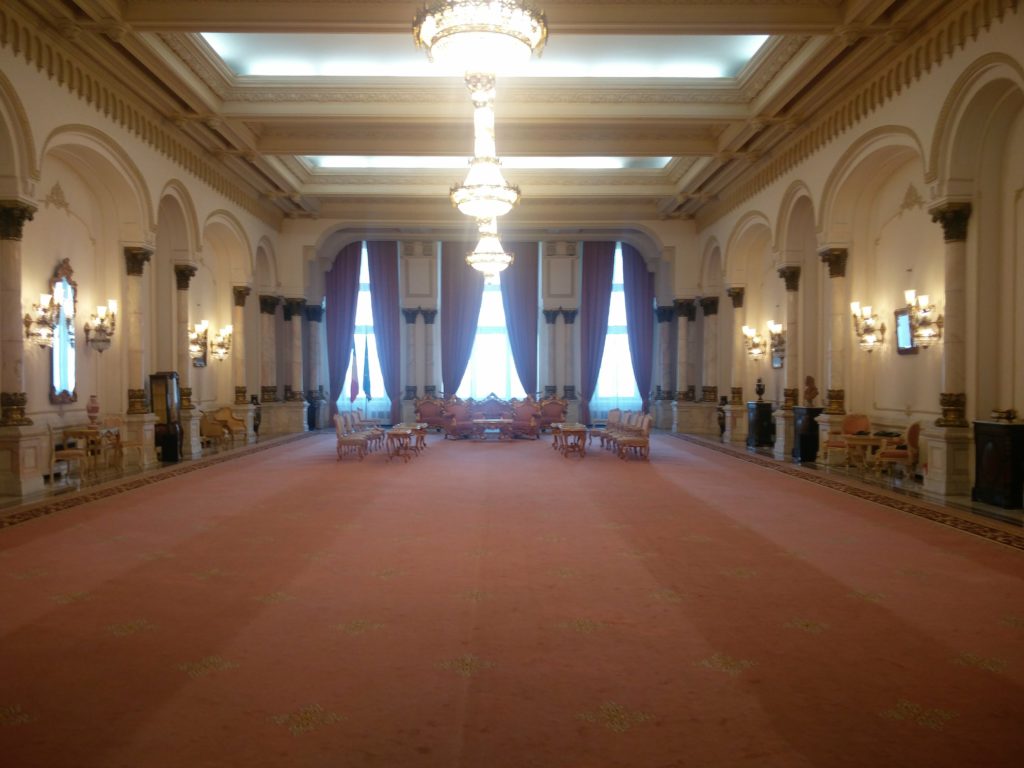
ID is mandatory
It’s not possible to visit the palace of the parliament if you don’t bring your ID. So don’t forget to bring your passport. After paying, the reception takes all the passports. You’ll get it back before leaving. Then everybody goes through a security gate, just like the ones in airports. They don’t play! And then the visit starts.

Palace of the Parliament stats
The palace of the parliament, it’s a living area of 350000 meters square! It measures 270 by 240 meters, with a height of 86 meters. It has more than 1100 rooms, on 12 different floors. 140 of those rooms are actually offices. Almost all the materials used in the construction of the palace of the parliament come from Romania (cristal for the chandeliers, silk for the curtains…). The cost of the palace is unknown, but it’s been estimated at 4 billion US dollars.

During the 1990s, Donald Trump was interested in this palace, and he wanted to buy it. The idea was to buy it, and turn it into the biggest casino in the world. But he declined when he was told that he could get the palace for 4 billion US dollars. Seeing how big this palace is, I totally understand the price! At the end of the visit, our guide told us we only covered 5% of the palace! You have to see it with your own eyes! If you spend some time in the country, check out this list of places to visit in Romania !
- Traveling soon? Check out my travel resources page! This list of travel accessories can also be useful!
- Do not travel without a travel insurance ! Here’s why buy travel insurance !
- Want a tailor made trip to Romania? Get a free quote here !
- Always use a VPN when traveling. I use ExpressVPN and I love it! Here’s why use a VPN when traveling .
- Romania is a cheap place to travel on a budget .
- No matter where you decide to go, check the latest flight prices , and check what are the hotels available here .

Sign up for exclusive updates in your e-mail address!
Related Posts
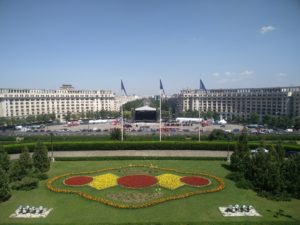
Reader Interactions
[…] of the most imposing buildings in Bucharest, the majestic Palace of the Parliament, is—as its name implies—the seat of the Romanian Parliament. This massive structure is located […]
Leave a Reply Cancel reply
Your email address will not be published. Required fields are marked *
Don't subscribe All new comments Replies to my comments Notify me of followup comments via e-mail. You can also subscribe without commenting.
This site uses Akismet to reduce spam. Learn how your comment data is processed .
The Palace of the Parliament in Bucharest
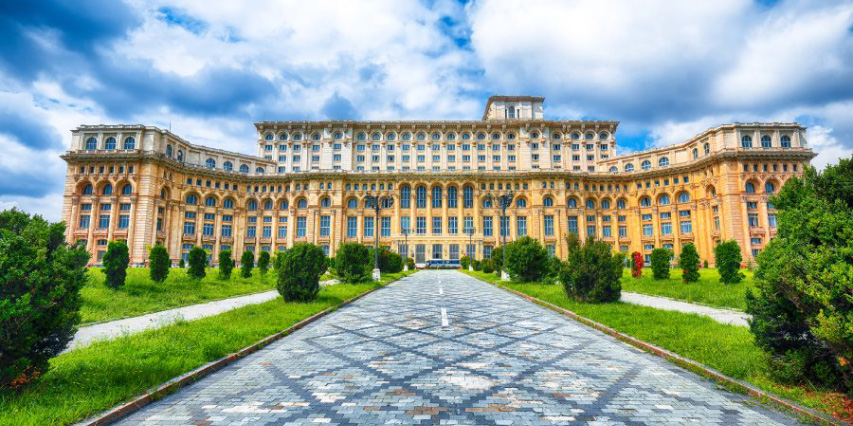
- Reasons to visit Romania
Quick, think for a moment: what’s the most impressive building that you have ever stepped foot in? Notre Dame? The Taj Mahal? The Great Mosque of Mecca? Although the list of beautiful, large, and amazing buildings that there are in this world is endless, the list of the biggest buildings in the world are short. And if you are looking at the list of heavy buildings, there is one that tops all else: The Palace of the Parliament . Located in Bucharest, Romania, this has been verified by the Guinness Book of World Records to be the heaviest building in the world. And weighing in at 9.0356 x 109 pounds, it is unlikely that there will be a heavier building ever, or at least not anytime soon!
What is the Palace of the Parliament?
If you are unfamiliar with this building, or even if you are familiar only with the name, you might be wondering, what exactly is the function of this building? Today it is a simple administrative building. It is the second largest administrative building, second on to the Pentagon. You can enter only through a guided tour, and it is a good idea to book tickets ahead of time. You will also need to bring your passport to be able to tour the building. The tour will last about 45 minutes.
What makes the Palace of the Parliament so heavy?
First, what makes it heavy is the sheer size of the building. It takes up a total of 365,000 square meters, or 3,930,000 square feet. But even though the Pentagon is significantly larger in size (the Pentagon is nearly double the square footage: 6,500,000 square feet!), what makes the Palace of the Parliament the heaviest building in the world is the materials used for its construction. The building is made out of 700,000 tons of steel and bronze, 350,000 square meters of marble, 3500 tons of crystal and 900,000 square meters of wood. Many have described this as a monstrosity of a building.
What is the history of the Palace of the Parliament?
Nicolae Ceaușescu was a Romanian communist politician and leader, serving as the leader of Romania from 1965-1989. He was a totalitarian leader and was considered to be one of the most repressive of the Eastern Bloc of that time. He had secret police spying on his own citizens and he did not know how to handle the country’s finances, leading to a lot of trouble for Romania.
In 1977 the Vrancea earthquake hit Romania and destroyed parts of Bucharest. Ceaușescu seized this opportunity to create a reconstruction plan for Bucharest . Having visited East Asia just a few years earlier in 1971, he was impressed by the societal organization in North Korea’s Juche ideology. He wanted to further develop Romania and put out a grandiose image to the world. After the earthquake, Ceaușescu had parts of old Bucharest destroyed and started designing a new Bucharest in socialist realism style. Socialist realism was an extremely idealized but realistic art form developed in the Soviet Union beginning in 1932. After World War II it was adopted by other socialist and communist countries.
During this time, Ceaușescu came up with what he called “Project Bucharest.” What he was looking for was a replica of Pyonyang in North Korea (if you look up pictures, you can note the similarities between the Kumsusan Palace of the Sun in North Korea’s capital and the Palace of the Parliament – the two buildings are quite alike). Ceaușescu created a nation-wide contest to find just the right architect for the job. He found a young, 28-year-old woman named Anca Petrescu for the job. She was chief architect, leading a team of 10 architects, who had another 700 architects under them. Construction began June 25, 1984.
When construction began, a total of 2.7 square miles (or 7 square kilometers) was demolished in the old city center of Bucharest. 40,000 people had to be relocated, and this work was forcibly carried out by soldiers to keep costs low. It is estimated that between 20,000 and 100,000 people ended up working on this grand Palace. They rotated between three shifts and there was a large number of “volunteers” who helped with the project. Thousands of people died during the construction – it is estimated that this project took the lives of nearly 3,000 people.
Unfortunately for Ceaușescu, he was never able to see the completion of this building. With the fall of communism in 1989, Ceaușescu was condemned to death and died on Christmas day. The building was not completed until 1997. Still, in 1990 Rupert Murdoch, the Australian-born business magnate, offered to buy the building for $1 billion. His bid was rejected, and in 2008 the Palace of the Parliament was estimated to be worth $3.4 billion (or 3 billion euros). This makes the Palace of the Parliament not only the heaviest building in the world, but also the most expensive administrative building. Even just the heating and electric costs $6 million, which is the amount that it costs to power a medium-sized city!
The interior of the Palace is quite ornate, with all the marble, and is divided into 23 sections. It is home to Romania’s two houses of Parliament (the Senate and the Chamber of Deputies), and an international conference center. It also has three museums: the National Museum of Contemporary art, the Museum of Communist Totalitarianism, and the Museum of the Palace. Many large events are held in this building, not just ones put on by Romanians but also by international bodies. The building hosts symposia, conferences, and others. Even with everything that goes on in this building, a whopping 70% of it goes unused. With rooms left completely empty.
The Palace of the Parliament is definitely worth a visit! It is beautiful, but it is also monstrous – not just in looks, but in its history too. Good luck getting a picture of this building – it is so big you have to be pretty far away to capture the entire thing in one frame!
We and our trusted third-party partners use cookies and other technologies to enhance site security, to improve and personalise your experience, as well as delivering tailored ads both on our own and other sites. For additional details view our Privacy and Cookies Statement

This Eastern European city was once known as ‘little Paris’ – but prices are a fraction of the French capital
Architecture lovers, coffee connoisseurs and historians will find themselves right at home in Bucharest, the Romanian capital.
This vibrant, sprawling city was once known as “little Paris ” due to the dominance of French architecture and broad boulevards that characterise the city centre.
In the Old Town and beyond, however, things are different again, with a tantalising mix of mediaeval, neoclassical, communist-era and contemporary buildings.
A large student population, plus a reputation for late-night boozing, makes Bucharest a popular destination to party, but it’s also a city with a rich and complex history worth discovering.
While many visitors use the city as a stop-gap between expeditions to Bran and Peleş Castle and the Carpathian Mountains, this is a city worth spending a weekend getting to know better.
Read more on Romania travel :
- How to have an affordable spa weekend in Bucharest
- St Pancras to Dracula’s Castle by train is three holidays in one
- The European city break with £2 pints and a spa you can spend all day in
Best things to do in Bucharest
Visit the church of the stavropoleos monastery.
This diminutive 18th-century church in the heart of the Old Town is one of Romania’s oldest. A perfect example of the Brancovenesc style (a hybrid of Byzantine, Ottoman and late Renaissance), its famed interior features colourful frescoes on the ceiling and walls, alongside religious icons and an intricately carved entrance. Attached to a working monastery occupied by just six nuns who restore old books, vestments and icons for the Vatican , the church is free to enter, but donations are welcomed. The adjacent courtyard also offers a peaceful place to rest and reflect in this busy area. Arrive early to beat the crowds.
Take a guided city tour
A city guide is always a great way to learn more about a new city, particularly if you’re short on time. The Walkabout Free Tour runs a series of city walks throughout Bucharest, in both English and Spanish which, as the name suggests, are free to join, although tips are encouraged. The The ‘Story of Bucharest’ tour provides an excellent overview of the city’s history, from Vlad the Impaler – the medieval prince said to be the inspiration for Bram Stoker’s Dracula – to Communism, architecture and the 1989 revolution.
Embrace the diversity of Bucharest’s architecture
Bucharest’s architecture is a captivating combination of neoclassical, byzantine, modernism, communist and Gothic, ensuring that a simple stroll around the city is never boring. Whatever your tastes, its diversity offers plenty to capture the imagination, from the neoclassical romance of the Romanian Athenaeum, to the brutalism of the Tehnoimport Building, the modernism of the InterContinental Bucharest , to the breathtaking eclecticism of The CEC Palace, Bucharest really is a feast for the eyes.
Hit the spa
One of the most popular attractions in Romania is Therme Spa. This colossal temple to wellbeing, situated 20 miles north of the city centre, is the biggest spa in Europe and worthy of all the superlatives and accolades it attracts. Home to 10 pools, 10 saunas, 17 water slides, and the largest urban beach in Europe, this supersized wellness establishment is also very reasonably priced to visit.
- Read our guide to Therme Spa
Best time to visit
Spring, autumn and winter are all good times to visit, depending on your personal preferences. Many residents flee the capital during the summer months when the mercury can reach 33C, making spring and autumn good times to visit temperature-wise. The wettest month is June, so it’s worth skipping if you plan to spend your trip outside and don’t like getting damp. If you’re a foodie, the annual Bucharest Street Food Festival takes place in April, while one of Europe’s biggest classical music festivals, the biennial George Enescu Festival , takes place in August or September every other year, with plans already underway for the 2025 edition.
Where to stay
Peakture hotel.
The four-star PeakTure Hotel is comfortable, contemporary and costs just €69 (£59) per night for a spacious double room. From here, it’s only a five-minute stroll to the picturesque Old Town. The hotel also has a superb offer that includes two nights accommodation and two day passes for Therme Spa for just €135 (£115) per person, based on two sharing.
The Marmorosch Bucharest, Autograph Collection
Housed in a 19th-century former bank, the Marmorosch Bucharest is an Art Deco dream decked out in marble, gold and velvet. Head to the subterranean Balance Spa for some R&R, or sip cocktails in the gilded Vault Bar before heading out. Arguably Bucharest’s best five-star hotel, expect opulence and luxury throughout, with silver rooms beginning at €166 (£142).
Bucuresti Bucuresti Hostel
If you’re on a budget, Bucuresti Bucuresti Hostel is well rated, with guests commenting on the warm welcome offered by owners Pauline and Daniel. Situated a 15-minute walk from the Old Town, the hostel offers air-conditioned single and dormitory rooms with free Wi-Fi from as little as £24 per night.
Where to eat
Romanian specialities include sarmale , which is ground pork, beef or veal rolled in cabbage leaves with a tomato sauce, served with polenta and sour cream – delicious. For pudding, try papanasi . Resembling fried donuts, these sweet treats have a soft cream and jam interior. La Mama serves up generous portions of this authentic cuisine for an absolute song.
Kane Seasonal Bistro
Splash out at Kane Seasonal Bistro, a fine-dining restaurant where the food must meet two requirements. One, ingredients must originate from farmers the chef knows personally, and secondly, the produce must be seasonal. Tasting menus are the order of the day here, with options for a short (10 dishes) or long (13 dishes) feast. Don’t leave without trying the sublime veal cheek with aubergine and onion.
Bread and Butter
This stylish spot is a popular brunch destination with both locals and tourists. On a weekend, it’s often heaving with folks people-watching, so get here early to grab an outside table. With a good selection of all-day breakfast options, including avocado and poached egg on toast, burgers (try the pulled-pork option) and loaded fries, it’s a good, central place to take a load off and refuel.
Where to drink
Fix me a drink.
This trendy botanics-led cocktail bar has a rotating menu, with short and tall glasses utilising locally sourced ingredients, such as pollen liquor and quince, to create innovative tipples. Try the Sunflower Seeds Lady, which combines roasted sunflower seeds, gin and fruit juices for a unique “Balkan vibes” taste. Low lighting, candles, plants, video art installations and a big disco ball add to the vibes.
Caru’ cu Bere
Even if you’re lukewarm about beer, it’s worth a visit to Caru’ cu Bere simply to gawp at its incredible Belle Epoque interior, ornate woodwork and stained-glass windows. As Bucharest’s oldest beer house, the venue continues to attract a healthy mix of locals and tourists, keen to partake in the house brew, while watching the regular live music and dancing. It gets busy, so it’s worth booking a table in advance, especially if you want to eat.
Origo Coffee
Coffee culture is big in Bucharest, with one report claiming that there are more cafes and roasteries per head than Berlin or Copenhagen. Origo Coffee, a popular spot for connoisseurs, offers blends from Ethiopia, Costa Rica, Brazil, Honduras and Colombia, alongside a selection of delicious cookies and treats. From 5pm, it turns into a buzzy cocktail bar. And with 276 teacups suspended from the ceiling, this stylish spot looks as good as it tastes.
Fork Restaurant
Opened in 2021, Fork is located on the 25th floor of Ana Tower. With an extensive wine cellar – try the fresh and moreish feteasca alba from the Romanian Strunga Winery – the floor-to-ceiling windows offer incredible views of this sprawling city. While their tasting menu doesn’t stand up against better options in the city, the beef tenderloin and sweet potato “mille feuille” was soft and succulent, and the wine was among the most delicious in Bucharest. Head up for happy hour and watch the sun go down with a glass of something delicious.
Where to shop
Cărturești carusel bookstore.
Arguably one of Europe’s prettiest bookshops, this six-storey store is a veritable shrine for bibliophiles. In addition to selling a host of Romanian and English-language books, vinyl, games, gifts and souvenirs, there’s also a bistro on the top floor, a multimedia space in the basement and a contemporary art gallery on the first floor.
This gorgeous “concept store” features fabulous work by Romanian designers, including artwork, furniture, jewellery, ceramics and more. We adored the modernist Malevich tea set in mint. Fortunately, they ship to the UK . Visits to their showroom are by appointment only, which is situated next to the serene Cismigiu park or you can browse and shop online.
Architectural highlight
Palace of parliament.
The third largest administrative building in the world, Bucharest’s Palace of Parliament is a herculean endeavour with a complex history. Standing at 84m in height, containing over 1,000 rooms, and with a floor area of 365,000sq metres, this Communist edifice is former dictator Nicolae Ceausescu’s controversial creation, inspired by his 1971 visit to North Korea. Work began in 1984, with 40,000 residents forcibly removed for building to commence and several thousand workers dying during its construction, according to unofficial reports. It remains unfinished to this day. Known locally as “the iceberg”, only five per cent of this gargantuan building is in use. Book ahead for a guided tour to gawp at football pitch-sized rooms of marble columns, gold-leaf ceilings and crystal chandeliers.
A standard tour starts at 60 lei (£10.30); book in advance online .
What currency do I need?
The Romanian lei (RON).
What language do they speak?
Romanian. English is taught in most schools and it’s estimated that around 40 per cent of Bucharest residents can speak it fluently. Learning a few key phrases in the mother tongue of your chosen destination is both sensible and thoughtful, however.
Should I tip?
It’s not mandatory to tip in Romania, but if you have received good service, anywhere between five to 20 per cent is welcome.
What’s the time difference?
What’s the average flight time from the uk.
Three hours and 15 minutes.
What’s the best view?
While the view from Fork Restaurant is impressive, you’ll need to head to SkyTower if you want to go higher. At 137 metres high, the skyscraper is the tallest building in the country. A ticket to the restaurant and viewing area on the 36th floor costs 100 lei (£17) and includes “a short tour for photos and a cocktail”.
Insider tip
Bucharest holds the unfortunate accolade of having some of the most congested traffic in Europe. Uber and Bolt are easy to navigate but it’s worth factoring in extra time for traffic if you’re planning on travelling around by car, particularly if you’re heading to the airport.
Getting there
Wizz Air , British Airways , Ryanair all fly direct to Bucharest from the UK.
Read more: Best hotels in Europe – where to stay for a city, beach or retreat break
The Independent is the world’s most free-thinking news brand, providing global news, commentary and analysis for the independently-minded. We have grown a huge, global readership of independently minded individuals, who value our trusted voice and commitment to positive change. Our mission, making change happen, has never been as important as it is today.

- Election 2024
- Entertainment
- Photography
- AP Buyline Personal Finance
- AP Buyline Shopping
- Press Releases
- Israel-Hamas War
- Russia-Ukraine War
- Global elections
- Asia Pacific
- Latin America
- Middle East
- Election Results
- Delegate Tracker
- AP & Elections
- Auto Racing
- 2024 Paris Olympic Games
- Movie reviews
- Book reviews
- Financial Markets
- Business Highlights
- Financial wellness
- Artificial Intelligence
- Social Media
France election highlights: Leftists win most seats, but no party wins majority
A coalition of the French left that quickly banded together to beat a surging far right in legislative elections won the most seats in parliament but not a majority, according to polling projections Sunday.
- Copy Link copied
Today’s live coverage has ended but there’s still plenty to catch up on. See what you missed below and find more coverage of the 2024 France elections on apnews.com.
A leftist coalition, the New Popular Front , has won the most seats in the 2024 French legislative election , beating back a far-right surge but failing to win a majority. The outcome leaves France facing the stunning prospect of a hung parliament and threatens political paralysis in a pillar of the European Union and Olympic host country.
Here’s what to know:
- Final results: The leftist coalition has taken the most seats in parliament. Emmanuel Macron’s centrists came in second and Marine Le Pen’s far-right National Rally is third.
- Prime minister offers to resign: Gabriel Attal plans to present his resignation on Monday but said if needed he could stay on through the Paris Olympics or longer.
- What happens next?: With Macron saying he’ll “wait” to make decisions on a new government, France now faces the prospect of weeks of political machinations to determine who will be prime minister and lead the National Assembly.
Far-left leader Jean-Luc Melenchon speaking last month. (AP Photo/Louise Delmotte)
Mélenchon has long been a figure on the left, first in the Socialist Party and as a senator. He founded the hard-left France Unbowed party in 2016 but failed to reach the presidential runoff in 2017 and 2022. He then allied his party with the Socialists, Communists and greens to form the New Popular Ecological and Social Union.
Mélenchon is a divisive figure who angers many moderates. The alliance fell into disarray because of divisions over the Hamas-Israel war. The France Unbowed party condemned the conduct of Israel’s war against Hamas and accused it of pursuing genocide against Palestinians. Party leaders denied antisemitism.
Then last month, Mélenchon’s party joined a similar alliance that was quickly thrown together for snap elections in response to the prospect of the far right gaining power. The alliance had more luck this time, winning the largest number of seats.
At the Place de la Republique. (AP Photo/Louise Delmotte)
Here’s a look at the final results from the second round. According to the Interior Ministry, the leftist coalition has taken the most seats in parliament, with at least 181. Macron’s centrists have more than 160 seats. Marine Le Pen’s far-right National Rally have 143 seats after leading in the first round.
No majority for anyone. The unpopular Macron will have to form alliances to run the government.
Many voters decided that keeping the far right from power was more important than anything else.
Correction: This post has been updated to remove exact seat tallies reported by French media to account for the fact that official results don’t give precise totals for each main bloc.
People gather on the Republique plaza following the second round of the legislative elections, Sunday, July 7, 2024 in Paris. (AP Photo/Aurelien Morissard)
“Our country is facing an unprecedented political situation and is preparing to welcome the world in a few weeks.” That’s from Prime Minister Gabriel Attal, who plans to offer his resignation on Monday.
The weakened Macron could seek a deal with the moderate left to create a joint government, but France has no tradition of this kind of arrangement. A deal could take the form of a loose, informal alliance that likely would be fragile. And already, leaders of the leftist New Popular Front are pushing Macron to give their alliance the first chance to form a government and propose a prime minister to share power with him.
If he can’t make a deal, Macron could name a government of experts unaffiliated with political parties to handle the day-to-day work of keeping one of Europe’s largest countries running. But that would require parliamentary approval. And the first session with new members of the 577-seat National Assembly is July 18.
Meanwhile, no clear figure has emerged as a possible prime minister. Macron’s office has said he would wait for the new National Assembly to take shape before taking “the necessary decisions.”
▶ Read more about what’s next
Midnight has passed in mainland France. Welcome to a new day. We await the final election results.
Speaking of suspense, a glance at the Paris Olympics countdown clock shows less than 19 days until the opening.
Far-right National Rally party leader Marine Le Pen speaks to reporters. (AP Photo/Louise Delmotte)
Far-right leader Marine Le Pen says France will be “totally deadlocked” with three groups of similar size in the National Assembly and none with a majority. But she says her National Rally party will be in a position to have a majority “maybe in a year.”
Sunday’s events have been a jolt for the party that hours ago seemed poised to make history by putting the far right in power for the first time since World War II.
Meanwhile, Le Pen is expected to run for president again in 2027. Macron can’t run again, but he has vowed to stay in office until the end of his term.
Fireworks at the Republique plaza. (AP Photo/Christophe Ena)
It’s been more than three hours since the first polling projections and a large crowd is still gathered in the Place de la Republique in Paris. A small number of people have climbed the large monument there and a few are waving flags. There have been fireworks.
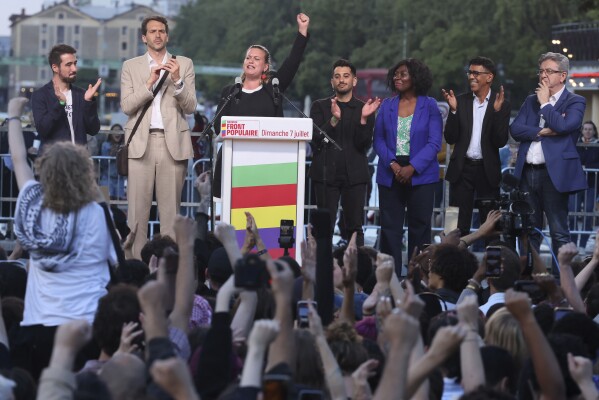
Far-left La France Insoumise - LFI - (France Unbowed) founder Jean-Luc Melenchon, right, and other party executives applaud Mathilde Panot, center, clenching her fist, after the second round of the legislative elections Sunday, July 7, 2024 in Paris. (AP Photo/Thomas Padilla)
They had just days to come together. The leaders of France’s left-wing parties have acknowledged they made compromises to unite in an effort to keep the far-right National Rally party from taking power in France.
The coalition calls itself the New Popular Front, named after a similar coalition formed in the 1930s against the rise of fascism in France. It includes environmentalist parties, the French Socialists and Communists and the hard-left France Unbowed party.
Ahead of Sunday’s vote, the leaders of the alliance’s four main parties promised unwavering support for Ukraine. They also promised to reverse a law that raised the retirement age from 62 to 64, raise the minimum wage, adjust salaries and pensions with the inflation rate, and freeze food and energy prices to boost people’s purchasing power.
▶ Read more about the New Popular Front
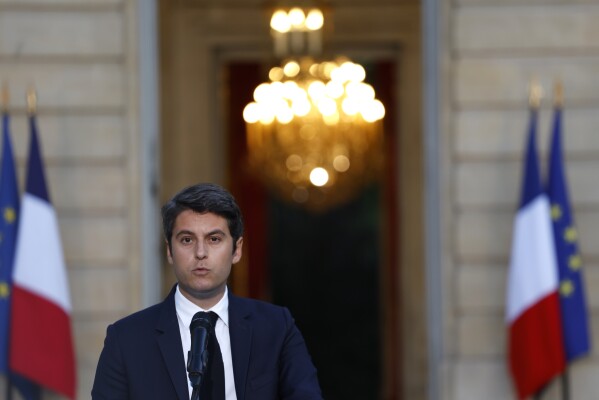
French Prime Minister Gabriel Attal delivers a speech after the second round of the legislative elections, Sunday, July 7, 2024 in Paris. (AP Photo/Aurelien Morissard)
French Prime Minister Gabriel Attal says he will turn in his resignation. This comes after projections show a leftist coalition has surged to the lead in legislative elections. But Attal says he will remain in the post during the Paris Olympics and for as long as needed.
The polling projections show that no party has won an outright majority. There likely will be weeks of intense political negotiations to choose a new prime minister and form a government. France’s president risks being forced to share power with a prime minister opposed to his pro-business, pro-European Union policies.
Attal became France’s youngest prime minister earlier this year.
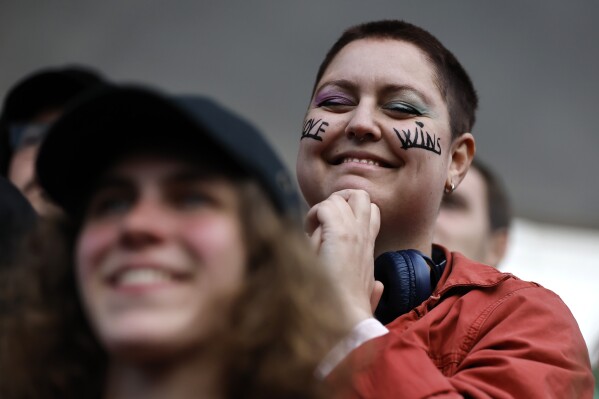
People react to the projection of results in Nantes, western France. (AP Photo/Jeremias Gonzalez)
There are growing crowds at République plaza, where the French left traditionally gathers. It erupted in cheers after surprise projections showed a leftist coalition ahead in legislative elections and the far right in third.
The leftist coalition quickly formed in response to speculation that the far-right, anti-immigration National Rally would surge to a historic victory. It could have meant the formation of France’s first far-right government since World War II.
“It’s important that France, one of the founders of the EU, doesn’t have a bad image in the world, the image of a country led by populists,” said Marie Lippini, a 24-year-old student from Aix-en-Provence.
Here’s the first comment from Macron. His office says he’s going to “wait” to make decisions on a new government.
The National Assembly is scheduled to gather in full session for the first time on July 18.
The statement says Macron will ensure the “sovereign choice of the French people will be respected.”
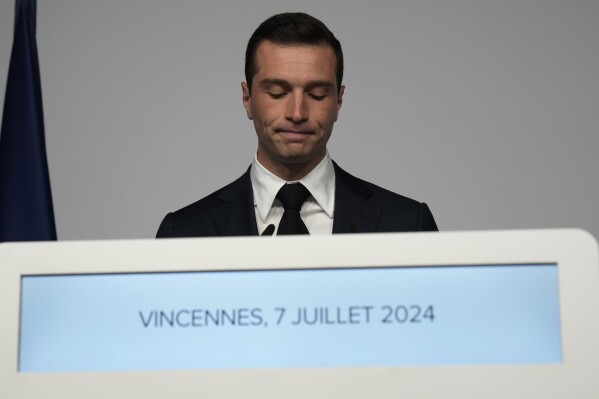
Far-right National Rally party president Jordan Bardella delivers a speech after the second round of the legislative election, Sunday, July 7, 2024 at the party election night headquarters in Paris. (AP Photo/Louise Delmotte)
Just minutes ago, Jordan Bardella with the far-right National Rally was thought to be in position to become France’s youngest prime minister. Now the 28-year-old is still claiming historic gains for the party after surprise polling projections put the far right in third place.
In a somber speech, Bardella is blaming Macron for “pushing France into uncertainty and instability.”
He also denounced the political maneuvering that led the National Rally to fall far short of expectations, though it still increased its seat count in parliament to an unprecedented high.
An unprecedented number of candidates who qualified for the runoff stepped aside to allow an opponent to go head-to-head with the National Rally candidate, increasing the chances of defeating them.
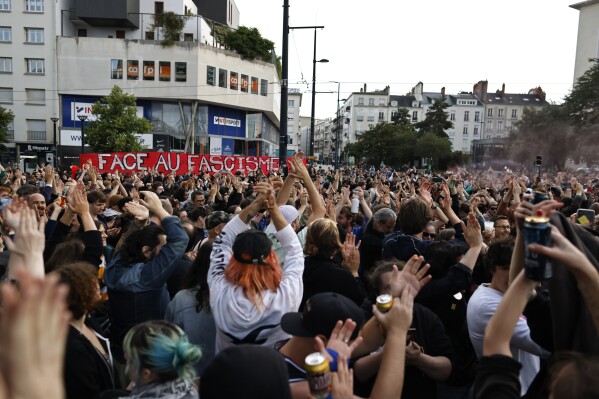
People react to the projection of results for the second round of the legislative elections, Sunday, July 7, 2024 in Nantes, western France. Voting is underway in mainland France on Sunday in pivotal runoff elections that could hand a historic victory to Marine Le Pen’s far-right National Rally and its inward-looking, anti-immigrant vision, or produce a hung parliament and political deadlock. Banner reads “In the face of fascism”. (AP Photo/Jeremias Gonzalez)
Far-left La France Insoumise - LFI - (France Unbowed) party members Mathilde Panot, right, and Rachel Keke wave to supporters at the party election night headquarters, Sunday, July 7, 2024 in Paris. A coalition on the left that came together unexpectedly ahead of France’s snap elections won the most parliamentary seats in the vote, according to polling projections Sunday. The surprise projections put President Emmanuel Macron’s centrist alliance in second and the far right in third. (AP Photo/Thomas Padilla)
People react to the projection of results during the second round of the legislative elections, near Republique Plaza in Paris, France. Polls have closed in France, and polling projections say a coalition on the left that came together unexpectedly has won the most parliamentary seats in the pivotal runoff elections after a high turnout among voters.(AP Photo/Christophe Ena)
People react to the projection of results for the second round of the legislative elections, Sunday, July 7, 2024 in Nantes, western France. Voting is underway in mainland France on Sunday in pivotal runoff elections that could hand a historic victory to Marine Le Pen’s far-right National Rally and its inward-looking, anti-immigrant vision, or produce a hung parliament and political deadlock. (AP Photo/Jeremias Gonzalez)
Supporters of the far-right National Rally party react after the release of the polling agencies projections for the second round of the legislative election, Sunday, July 7, 2024 at their election night headquarters in Paris. A coalition on the left that came together unexpectedly ahead of France’s snap elections won the most parliamentary seats in the vote, according to polling projections Sunday. The surprise projections put President Emmanuel Macron’s centrist alliance in second and the far right in third. (AP Photo/Louise Delmotte)
Supporters of the far-left La France Insoumise - LFI - (France Unbowed) parry react at the party election night headquarters, Sunday, July 7, 2024 in Paris. A coalition on the left that came together unexpectedly ahead of France’s snap elections won the most parliamentary seats in the vote, according to polling projections Sunday. The surprise projections put President Emmanuel Macron’s centrist alliance in second and the far right in third. At left is LFI’s Mathilde Pant and at center Manuel Bompard. (AP Photo/Thomas Padilla)
The timing of France’s leap into the political unknown could hardly be worse: With the Paris Olympics opening in less than three weeks, the country will be grappling with domestic instability when the eyes of the world are upon it.
Supporters of the far-left France Unbowed party celebrate. (AP Photo/Thomas Padilla)
The speech by leftist leader Mélenchon is an indication of what’s ahead. He says he will not negotiate with Macron, and Macron has refused to negotiate with him.
Who will lead the government? There is no deadline to form a new one. There could be weeks of discussions ahead. Macron faces the prospect of leading the country alongside a prime minister opposed to most of his domestic policies.
The sharp polarization of French politics is sure to complicate any coalition-building effort. And any cobbled-together majority risks being vulnerable to no-confidence votes that could cause it to fall.
This is uncharted territory for France. Unlike other countries in Europe that are more accustomed to coalition governments, France doesn’t have a tradition of lawmakers from rival political camps coming together to form a working majority.
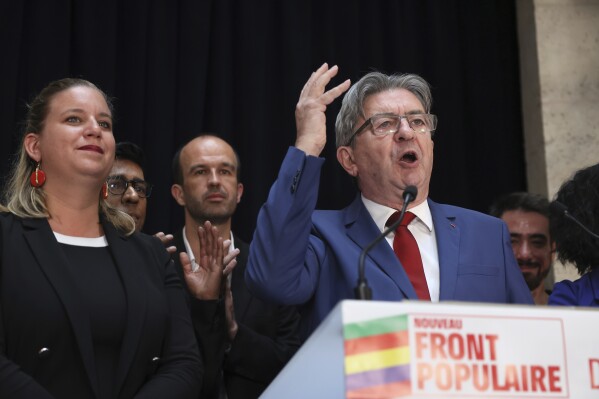
Far-left La France Insoumise - LFI - (France Unbowed) founder Jean-Luc Melenchon delivers a speech at the party election night headquarters, Sunday, July 7, 2024 in Paris. (AP Photo/Thomas Padilla)
Leftist leader Jean-Luc Mélenchon calls the results an “immense relief for a majority of people in our country.” He wants the prime minister to resign.
Mélenchon is the most prominent of the leftist leaders who unexpectedly came together ahead of the two-round elections to keep the far right from power. Polling projections have put the leftist coalition in front, followed by President Emmanuel Macron’s centrist alliance and the far right in third.
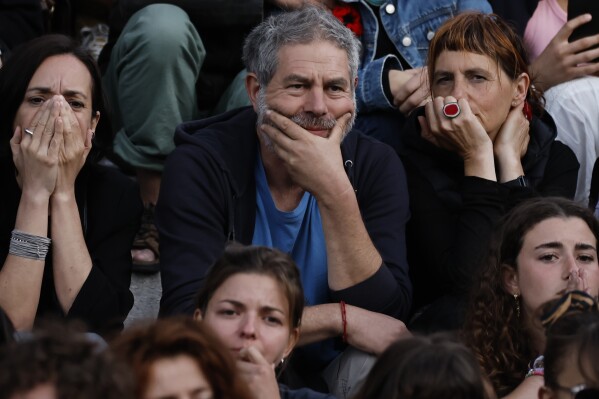
People wait for the results of the second round of the legislative elections, Sunday, July 7, 2024 in Nantes, western France. (AP Photo/Jeremias Gonzalez)
The lack of majority for any single alliance has plunged France into political and economic turmoil.
Final results are not expected until late Sunday or early Monday. The deeply unpopular Macron has lost control of parliament, according to the projections. The far right National Rally drastically increased the number of seats it holds in parliament but fell far short of expectations.
France now faces the prospect of weeks of political machinations to determine who will be prime minister and lead the National Assembly. And Macron faces the prospect of leading the country alongside a prime minister opposed to most of his domestic policies.
The first projections say French leftists have won most seats in legislative elections. The surprise projections put President Emmanuel Macron’s centrist alliance in second and the far right in third.
Republique plaza, where supporters of the left were gathered, has erupted into cheers.
▶ While we wait for the first projections, here’s a look at the possible election outcomes .
Ballot-counting begins in Schiltgheim, eastern France (AP Photo/Jean-Francois Badias)
One hour to go before polls close everywhere. We should have the first polling projections then.
In a sign of the uncertainty, far-right National Rally party leader Jordan Bardella won’t be speaking publicly for at least an hour after polls close. Marine Le Pen’s address is set for two hours after the initial results. Both spoke within minutes of polls closing in the first round.
Some big-name stores in Paris are protecting their windows in case of unrest as results come out, but that’s a pretty common precaution.
FILE - Kylian Mbappe of France controls the ball during a Group D match between Austria and France at the Euro 2024 soccer tournament in Duesseldorf, Germany, Monday, June 17, 2024. (AP Photo/Alessandra Tarantino, File)
The captain of France’s national team, Kylian Mbappé, had urged young people to vote and warned against “extremes” at a time when the far right seeks to take power in the parliamentary elections. He didn’t name any politicians or parties by name.
“We are a generation that can make a difference. We can see that the extremes are knocking on the door of power, and we have the opportunity to shape the future of our country,” he said while France prepares to play Spain in the Euro 2024 semifinals on Tuesday.
Teammates Marcus Thuram and Ousmane Dembélé have also expressed strong opinions about domestic politics and the need to vote.
▶ Read more about Mbappe’s comments
Macron in Le Touquet-Paris-Plage. (Mohammed Badra, Pool via AP)
Macron is meeting with leaders from his weakened majority alliance before polls close. An aide to the president says Prime Minister Gabriel Attal is there. The aide spoke on condition of anonymity to discuss the closed-door meeting.
Many of Macron’s centrist political allies are furious at his decision to call the surprise elections just three weeks after the far-right National Rally trounced his party in European elections. They fear the centrist coalition will be wiped out in favor of the far right and left.
A voter makes her choice in Le Touquet-Paris-Plage in the north. (Mohammed Badra, Pool via AP)
Some French youth are astonished by the number of people supporting the far-right National Rally.
Nawel Marrouchi is 15 and wishes she was old enough to vote. “As a binational, I am directly concerned,” the French-Moroccan said in Paris. She fears racism will gain even more ground: “In my class, one guy said once that foreigners shouldn’t get housing. But my father was an immigrant. They should go to these countries to understand why they are coming here.”
Jessica Saada is 31 and says “I think young people have not woken up yet. They don’t realize.” She is baffled by the party’s past and present positions on issues like wearing a headscarf in public: “It’s just going to cause problems and bring more hate.” Even if the anti-immigration party doesn’t win a majority in parliament, she believes the damage is done.
A couple leaves the voting station in Olwisheim, eastern France. (AP Photo/Jean-Francois Badias)
With three hours to go before polls close, here’s the latest figure on the turnout: 59.71%. It’s the highest turnout since 1981 at this time in the voting day. The overall turnout is on track to be the highest in four decades.
In the restive French Pacific territory of New Caledonia, a pro-independence Indigenous Kanak candidate has won a seat in France’s parliament over a loyalist candidate in the second round of voting.
Emmanuel Tjibaou is a political novice and a son of a well-known Kanak independence leader, Jean-Marie Tjibaou, who was assassinated in 1989. He is the first pro-independence candidate to win a seat in the National Assembly since 1986.
Indigenous Kanaks have long sought to break free from France, which took the archipelago in 1853. Polls closed earlier in New Caledonia because of a curfew imposed in response to the violence that flared last month, leaving nine people dead. There was anger over an attempt to amend the French Constitution and change voting lists, which Indigenous Kanaks feared would further marginalize them.
Right-wing candidate and French loyalist Nicolas Metzdorf has won New Caledonia’s second parliament seat.
▶ Read more about New Caledonia
An abandoned pithead building is pictured in Henin-Beaumont, northern France, Sunday, June 30, 2024. A depressed former mining town is at the heart of French far-right leader Marine Le Pen’s long-term political strategy. Her party’s electoral success Sunday came as no surprise to the hundreds of fierce supporters who had gathered in the town of Henin-Beaumont to see her victory speech. (AP Photo/Thibault Camus)
Le Pen planted herself in the northern town of Henin-Beaumont in the early 2000s, hoping to win over disenchanted voters feeling left behind by the new economy. It was the start of a decade-long effort to detoxify her anti-immigration National Rally and win over voters from across French society.
Although France has some of the highest standards of living in the world, lower unemployment than it’s had in decades and a relatively low crime rate, discontent has simmered in some areas in the post-industrial era. For many National Rally voters, last Sunday’s victory is revenge on a political class that they see as out of touch with everyday people and their concerns including crime, purchasing power and immigration.
Henin-Beaumont is where Le Pen began to turn her father’s party from political pariah to a voter-friendly alternative. She sought to replicate that strategy on the national level when she took the reins of the party in 2012.
▶ Read more about Le Pen’s early success in Henin-Beaumont .
FILE - People use their smartphones near the Olympic rings that are displayed on the Eiffel Tower in Paris, June 7, 2024 in Paris. (AP Photo/Aurelien Morissard, File)
More than a dozen reports issued in the past year point to an intensifying effort from Russia to undermine France, particularly the upcoming Olympic Games, and President Emmanuel Macron, who is one of Ukraine’s most vocal supporters in Europe.
Some of those campaigns include photos of blood-red hands on a Holocaust memorial. Caskets at the Eiffel Tower. A fake French military recruitment drive calling for soldiers in Ukraine, and major French news sites improbably registered in an obscure Pacific territory, population 15,000.
▶ Read more on how the elections and Olympics have sent these disinformation campaigns into overdrive.
A voter casts her ballot during the second round of the legislative elections, Sunday, July 7, 2024 in Paris. (AP Photo/Louise Delmotte)
A woman casts her ballot in the second round of the legislative elections, Sunday, July 7, 2024 in Strasbourg, eastern France. (AP Photo/Jean-Francois Badias)
A woman casts her ballot during the second round of the legislative elections in Le Touquet-Paris-Plage, northern France, Sunday July 7 2024. (Mohammed Badra, Pool via AP)
A voter casts his ballot during the second round of the legislative elections, in Lyon, central France, Sunday, July 7, 2024. (AP Photo/Laurent Cipriani)
A woman picks up ballots at a polling station to vote in the second round of the legislative elections, in Lyon, central France, Sunday, July 7, 2024. (AP Photo/Laurent Cipriani)
A man picks up ballots in a the voting station during the second round of the legislative elections, Sunday, July 7, 2024 in Olwisheim , eastern France. (AP Photo/Jean-Francois Badias)
A woman casts her ballot in the second round of the legislative elections, Sunday, July 7, 2024 in Rennes, western France. (AP Photo/Jeremias Gonzalez)
The French flag flies atop the French National Assembly Wednesday, July 3, 2024 in Paris. (AP Photo/Thibault Camus)
Opposition parties made hurried deals to try to block a landslide victory for Marine Le Pen’s far-right National Rally in the second round of legislative elections, as she said her party would lead the government only if it won an absolute majority — or close to it.
An unprecedented number of candidates who qualified for round two from the left-wing alliance of the New Popular Front and from President Emmanuel Macron’s weakened centrists have stepped aside to favor the candidate most likely to win against a National Rally opponent.
According to a count by French newspaper Le Monde, some 218 candidates who were eligible to compete in the second round have pulled out. Of those, 130 were on the left, and 82 came from the Macron-led centrist alliance Ensemble.
▶ Read more about how the parties responded to round 1 of voting.
President Emmanuel Macron, right, votes in Le Touquet-Paris-Plage, northern France. (Mohammed Badra, Pool via AP)
French President Emmanuel Macron has voted in high-stakes legislative elections that could force him to share power with the rising far right.
Macron called the surprise vote after the anti-immigration, nationalist National Rally made huge gains in the June 9 European elections, taking a huge gamble that French voters would block the far-right party as they always have in the past.
But the National Rally instead won a larger share than ever in the first round on June 30, and its leader Marine Le Pen called on voters to give the party an absolute majority in Round 2.
Sunday’s vote determines which party controls the National Assembly and who will be prime minister. If no party wins an absolute majority, forming a government comes only after extensive negotiations.
As of noon local time, turnout was at 26.63%, according to France’s interior ministry. That’s slightly higher than the 25.90% reported at the same time during the first round of voting last Sunday.
Voters at a Paris polling station were acutely aware of the elections’ far-reaching consequences for France and beyond.
“The individual freedoms, tolerance and respect for others is what at stake today,” said Thomas Bertrand, a 45-year-old voter who works in advertising.
He voted at a school where, as at all French schools, the national motto “Liberty, Equality, Fraternity” was displayed prominently.
Pierre Lubin, a 45-year-old business manager, was worried about whether the elections would produce an effective government.
“This is a concern for us,” Lubin said. “Will it be a technical government or a coalition government made up of (different) political forces?”
Even with the outcome still in doubt, Valerie Dodeman, a 55-year-old legal expert, said she is pessimistic about the future of France.
“No matter what happens, I think this election will leave people disgruntled on all sides,” Dodeman said.
French PM Attal casts vote in pivotal runoff election that could propel the far-right to power
Prime Minister Gabriel Attal has cast his ballot in the Paris suburb of Vanves.
Macron is expected to vote later in the seaside town of La Touquet, while Le Pen is not voting after winning her district in northern France outright last week. Across France, 76 candidates secured seats in the first round, including 39 from Le Pen’s National Rally, 32 from the leftist New Popular Front alliance, and two candidates from Macron’s centrist list.
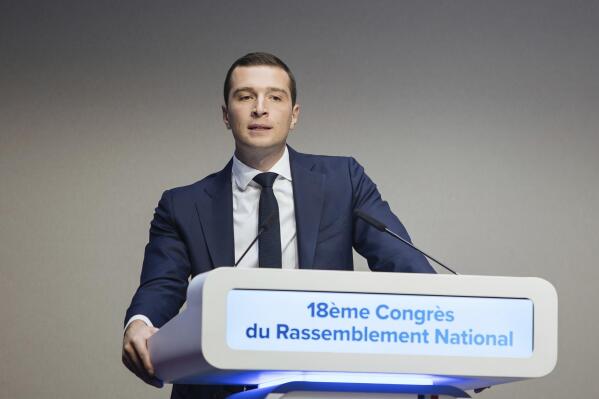
Chief of the National Rally party Jordan Bardella speaks on stage during the party congress in Paris, Saturday, Nov. 5, 2022. (AP Photo/Lewis Joly)
At just 28 years old, Jordan Bardella has helped make the far-right National Rally the strongest political force in France. And now he could become the country’s youngest prime minister.
After voters propelled Marine Le Pen’s National Rally to a strong lead in the first round of snap legislative elections, Bardella turned to rallying supporters to hand their party an absolute majority in the decisive second round that would allow the anti-immigration, nationalist party to run the government, with Bardella at the helm.
Bardella is part of a generation of young people who joined the party under Marine Le Pen in the 2010s but likely wouldn’t have done so under her father.
▶ Read more about Jordan Bardella
Voting has opened in France for the second round of high-stake legislative elections that have already seen the largest gains ever for the country’s far-right National Rally party.
French President Emmanuel Macron took a huge gamble in dissolving parliament and calling for the elections after his centrists were trounced in European elections on June 9. The first round on June 30 saw the largest gains ever for the anti-immigration, nationalist National Rally, led by Marine Le Pen. Sunday’s vote determines which party controls the National Assembly and who will be prime minister.
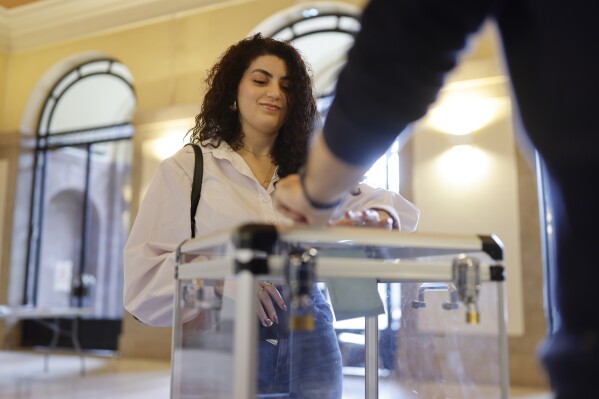
If support is further eroded for Macron’s weak centrist majority, he will be forced to share power with parties opposed to most of his pro-business, pro-European Union policies.
The second-round voting began Saturday in France’s overseas territories from the South Pacific to the Caribbean, Indian Ocean and North Atlantic. The elections wrap up Sunday at 8 p.m. (1800 GMT) in mainland France. Initial polling projections are expected Sunday night, with early official results expected late Sunday and early Monday.
FILE - French far right leader Marine Le Pen reacts as she meets supporters and journalists after the release of projections based on the actual vote count in select constituencies , Sunday, June 30, 2024 in Henin-Beaumont, northern France. (AP Photo/Thibault Camus, File)
French voters face a decisive choice in the runoff of snap parliamentary elections that could see the country’s first far-right government since the World War II Nazi occupation — or no majority emerging at all.
Official results suggest Marine Le Pen’s anti-immigration, nationalist party National Rally stands a good chance of winning a majority in the lower house of parliament for the first time, but the outcome remains uncertain amid the complex voting system and political tactics.
▶ Read more on what to expect from today’s election.

IMAGES
VIDEO
COMMENTS
Visiting the Palace of the Parliament in Bucharest is truly breathtaking. Read my experiences visiting this building & learn how to book a tour yourself.
Bucharest's Palace of the Parliament, formerly known as "The House of the People" ("casa poporului"), is one of Romania's most iconic landmarks. The socialist-era building is the second-largest government building in the world and will likely be at the top of your to-do list if you're planning a trip to Bucharest.
Explore the Palace of Parliament, the second largest administrative building in the world, and marvel at its impressive architecture and history.
Book tours and tickets to experience Palace of Parliament (Palatul Parlamentului). Reserve a ticket for your trip to Bucharest today. Free cancellation and payment options - Viator.
Standard Tour + Underground (access only on stairs) The Press Gallery - The Gallery of Honour - The "Nicolae Iorga" Hall - The "Nicolae (...) Request. Last events. Palace of Parliament Halls. Romanian Parliament - International Conference Centre.
Tour one of the most impressive buildings in Europe, and one of the biggest in the world, on a convenient guided tour. You'll get to explore the inside of the Romanian Parliament building with an informative local guide, so you'll leave with a greater understanding of Romania's history and politics. It's a must-visit sight in Bucharest, and will help you understand the huge role that ...
The building of the Palace of Parliament is the most important symbol of the Communist architecture in Bucharest. Along the tour you walk up and down the main staircases of the building to see the impressive hallways, meeting and conference rooms located at different flours in the building.
Visit Bucharest's main attraction, the Palace of Parliament. Admire the architectural stature of the 9-story building and ornately decorated interiors on a guided tour in English.
On this guided tour of the Palace of Parliament in Bucharest, we'll visit the most important and iconic rooms of the world's largest administrative building.
Go on a guided tour of the Palace of Parliament, a must-see when visiting Bucharest. Stroll through enormous hallways and rooms, see busts of Romanian kings, and visit Europe's biggest ballroom.
Visit the Palace of Parliament Bucharest | The heaviest building in the world The Palace of Parliament Bucharest is one of the most popular buildings in Europe. This colossal structure stands as a reminder of Romania's tumultuous political past, showcasing exquisite architecture and opulent interiors.
The Palace of the Parliament ( Romanian: Palatul Parlamentului ), also known as the House of the Republic ( Casa Republicii) or People's House/People's Palace ( Casa Poporului ), is the seat of the Parliament of Romania, located atop Dealul Spirii in Bucharest, the national capital. The Palace reaches a height of 84 m (276 ft), [1] has a floor ...
When you can see a building from space, you know it's bound to be a statement up close. Get fast-track entrance and a guided tour of Bucharest's Palace of the Parliament, and glimpse the extravagant architectural ambition and neoclassical style evident in every square inch of the world's second-largest administrative building.
Explore the largest building in Europe on this comprehensive tour of Romania's Parliament, with skip-the-line access.
With over 1,100 rooms spread across an area of 365,000 m2, the Palace of Parliament is the second-largest administrative building and the heaviest building in the world. The architectural style of the Palace of Parliament is a blend of neoclassical and socialist realism, characterized by large supporting columns, long doors, lavish staircases ...
How does it feel visiting the Palace of the Parliament in Bucharest, the world's heaviest building? See here 20 facts, photos, and a video.
The palace of the Parliament is a must see when you go to Bucharest. It's the world's second largest administrative building, after the Pentagon. It's also the most expensive administrative building and the heaviest building in the world. And honestly, when you visit it, you understand why the palace of the parliament holds all this records!
House of the People or Palace of Parliament in Bucharest, Romania. The second largest civilian building on Earth, after the Pentagon and a main tourist attraction in Bucharest. Address: Izvor Street, 2-4. 050563. Bucharest, Phone: 021 316 0300. The Palace of Parliament housed the largest NATO summit ever.
We enjoyed our Palace of Parliament Tour Bucharest. It was even bigger than we imagined. Take a sneak peek inside this gargantuan building. THE BEST TOURS & ...
And if you are looking at the list of heavy buildings, there is one that tops all else: The Palace of the Parliament. Located in Bucharest, Romania, this has been verified by the Guinness Book of World Records to be the heaviest building in the world. And weighing in at 9.0356 x 109 pounds, it is unlikely that there will be a heavier building ...
For visiting the Palace of Parliament, the entrance tickets may be purchased the day of your visit only from the ticket office located within the "Constantin Brancusi" Exhibiton Hall, 2-4, Izvor Street.
Demonstrations inside the Palace of Parliament are strictly forbidden. Do not sit on the stairs or any of the furniture during the tour. Please be quiet and mindful of your surroundings during the tour so as not to disturb parliamentary sessions or conferences in progress. Regulations regarding processing personal data to gain entry inside the ...
The The 'Story of Bucharest' tour provides an excellent overview ... Palace of Parliament. The third largest administrative building in the world, Bucharest's Palace of Parliament is a ...
Explore the largest building in Europe on this comprehensive tour of Romania's Parliament. Discover the largest halls, unique interiors and opulent decorations in one of the most interesting buildings in Eastern Europe. Benefit from skip-the-line access.
Official results suggest Marine Le Pen's anti-immigration, nationalist party National Rally stands a good chance of winning a majority in the lower house of parliament for the first time, but the outcome remains uncertain amid the complex voting system and political tactics. Read more on what to expect from today's election.
Far right projected to finish third in French elections. A coalition of left-wing parties known as the New Popular Front was projected to come in first in legislative elections in France ...
A left-wing coalition unexpectedly surged and the far-right National Rally fell short of predictions. But no coalition captured a majority in Parliament, meaning months of gridlock could lie ahead.